Last updated 22 March 2019
DE HAVILLAND DH.86 IN AUSTRALIA
Compiled by Geoff Goodall
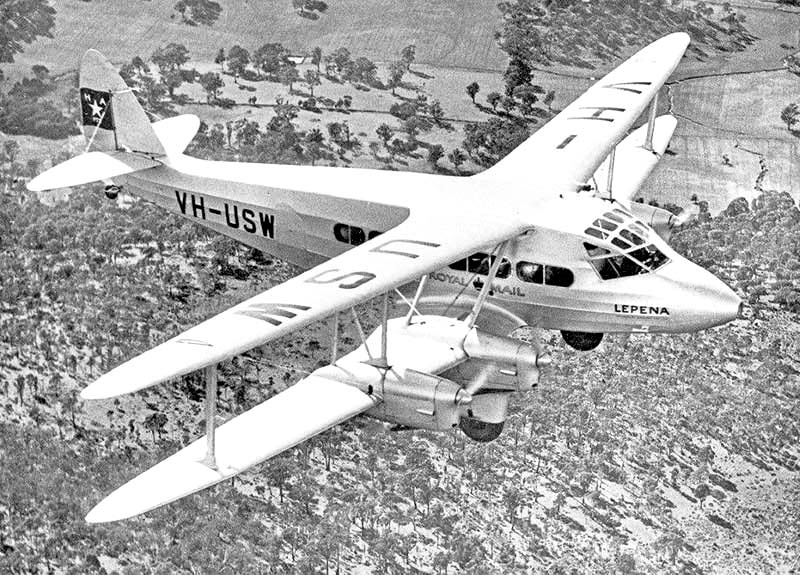
VH-USW led an adventurous life before it was abandoned in India in 1946. Photo: Neil Follett collection
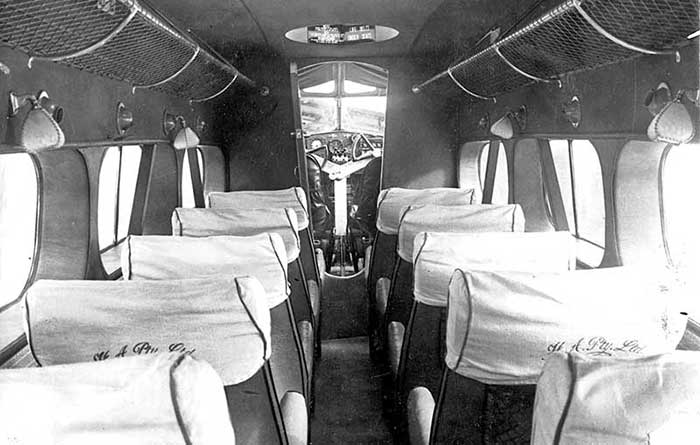
Photograph courtesy Civil Aviation Historical Society
Although never given a name by De Havilland Aircraft, the type was widely known in Australia and NZ as the Express Liner,
or just DH.86 Express. Imperial Airways referred to the type as their Diana Class. The original single-pilot nose was quickly redesigned for dual controls as required by the joint order for Imperial Airways/Qantas Empire Airways, to allow Captain and First Officer to sit side by side on the Empire Air Mail route. The Qantas order was for five new aircraft and Holyman’s Airways immediately ordered two DH.86s to replace DH.84 Dragons on their Tasmania-Melbourne services.
De Havilland were to build a total of 62 DH.86s at the Hatfield Aerodrome factory between 1933-1937. They were all wood construction with fabric covering, the design was continuously modified during production. The main models were:
| DH.86 |
Production dual-control model, commenced after fourth aircraft built |
| DH.86A |
from c/n 2333: steeper sloping windscreen, pneumatic undercarriage
legs, larger brakes and tailwheel, metal framed rudder. All surviving DH.86A were modified to DH.86B standard during 1937. |
| DH.86B |
Last 10 production aircraft: auxiliary fins on each side of the horizontal tailplane to improve rudder and aileron control, increased tailplane chord |
British aeroplane)
In February 1935, when the Australian Civil Aviation Branch lifted the first grounding order on Austraian DH.86s, Qantas was able to commence the Brisbane-Darwin-Singapore return sector with their DH.86s, with air mail collection/delivery to other ports en route:
- Darwin: connections with MMA (airmail from Perth) and Guinea Airways (airmail from Adelaide)
- Charleville: connections with Butler Air Transport (airmail from Sydney, via rail to/from Cootamundra)
Senior Qantas Captain Lester Brain wrote a report to General Manager Hudson Fysh after test flying the first Qantas DH.86 VH-USC in England, following his initial flights in the prototype single pilot cockpit D.H.86 G-ACPL Delphinus. He immediately identified a basic design flaw: “The glide float, and takeoff and landing characteristics are much the same as on the prototype Delphinus. The fitting of flaps is essential for continued operations and is urged. The dual cockpit is a vast improvement over the prototype and must be considered satisfactory.” Qantas installed flaps to their DH.86s at their Brisbane hangar, and by June 1935 all had been modified.
Not long after after the Qantas DH.86s commenced the Brisbane-Darwin-Singapore scheduled mail and passenger service, negotiations were already under way to replace landplanes on the joint Imperial Airways/Qantas Empire Air Mail service with large flying boats, culminating in the introduction of the Short S.23 “C” Class boats in 1938. These were faster but limited to daytime flying because of the water landing sites. The final Qantas DH.86 service arrived at Singapore on 18 July 1838, Qantas issuing a press statement that their DH.86s had flown 2,600,000 miles over the previous three and a half years, without any injury to passengers or crew.
When the flying boats were introduced on the Empire Air Mail service, Qantas sold three DH.86s and retained two on the airline’s Brisbane-Darwin route and western Queensland services. Australian National Airways and its predecessor Holyman’s Airways had been flying the type on airline services since 1934. MacRobertson Miller Aviation Co in Perth purchased two of the Qantas DH.86s as a stop-gap to replace DH.84 Dragons on their long distance Perth-Darwin service while waiting for two new Lockheed 10 Electras ordered from USA.
In 1937 the DH.86 production line received a late boost with an order
for three new DH.86Bs placed by the Sydney shipping and merchant
company W.R.Carpenter & Co Ltd. The company had built up
Mandated Airlines at Salamaua, New Guinea into a thriving domestic
aviation business and was anxious to operate the first airline service
from
Sydney to Salamaua and on to Rabaul, New Britain. After frustrating
delays because of lack of suitable aircraft types, Sir
Walter Carpenter was able to secure the route, initially without an
airmail contract, and ordered the DH.86s. The service commenced on 30
May 1938 under the name of W.R. Carpenter Airlines and proved to be a
reliable and highly essential communications link with the Australian
Territory of Papua and New Guinea. It was a weekly service in
each direction, taking two and a half days between Sydney-Rabaul.
After the loss of two W.R.Carpenter DH.86Bs, Flight Superintendent Dick Mant was sent to Singapore by Qantas flying boat service in April 1940 to inspect and purchase two second-hand DH.86s being advertised for sale by Wearns Air Service. They were quickly flown to Sydney to become VH-UZX & VH-ADN, to maintain Carpenter Airlines services prior to the arrival of two Lockheed 14s ordered in USA. Unfortunately for Carpenters, the worsening war situation resulted in both these replacement DH.86s being quickly taken from them when impressed for RAAF. The original Carmania struggled on maintaining the service, with all seats booked months in advance, until the Lockheed 14s commenced in May 1941, introducing New Guinea residents to the luxury of an air hostess.
After the loss of two W.R.Carpenter DH.86Bs, Flight Superintendent Dick Mant was sent to Singapore by Qantas flying boat service in April 1940 to inspect and purchase two second-hand DH.86s being advertised for sale by Wearns Air Service. They were quickly flown to Sydney to become VH-UZX & VH-ADN, to maintain Carpenter Airlines services prior to the arrival of two Lockheed 14s ordered in USA. Unfortunately for Carpenters, the worsening war situation resulted in both these replacement DH.86s being quickly taken from them when impressed for RAAF. The original Carmania struggled on maintaining the service, with all seats booked months in advance, until the Lockheed 14s commenced in May 1941, introducing New Guinea residents to the luxury of an air hostess.
An indication of the difficulties of W.R. Carpenter's long airline route from Sydney to Rabaul is given in this recollection by senior pilot Captain Ken Jackson: "Flying on the route presented its challenges, largely due to the lack of radio navigation aids. Apart from the fact that the DH.86s were unstable longitudinally, they were quite a nice aeroplane and the four Gipsy Six engines were very reliable. One of the most difficult parts of the DH.86 operation was that we were scheduled out of Port Moresby, New Guinea at 2.40pm to go over the Owen Stanley Ranges to Salamaua. Nobody ever flew over these mountains after midday, because every afternoon the cumulonimbus clouds built up and, with mountains up to 15,00 feet, you never went into cloud and never flew blind. To get across the ranges one day, I had a DH.86 up to 19,000 feet, without oxygen. But we always managed to make the trip to Salamaua and never had to turn back."
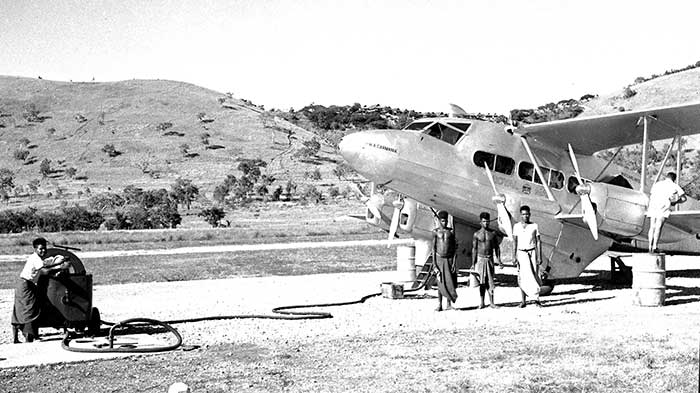
W.R.Carpenter Airlines DH.86B VH-UYU Carmania refuels at Port Moresby.
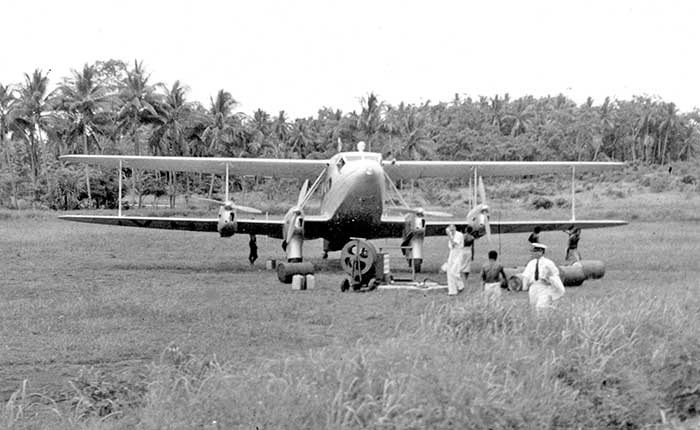
Carpenter Airlines DH.86B at Rabaul after the long flight from Sydney. Note the pilot in white uniform.
Both Carpenters photographs by Arch Dunne via Greg Banfield
Both Carpenters photographs by Arch Dunne via Greg Banfield
The story of DH.86 airworthiness is long and complex. Its reputation was tarnished from the beginning when Holyman's Airways' first DH.86 VH-URN disappeared in the sea between Tasmania and Melbourne in October 1934 only a fortnight after entering service. A month later Qantas Empie Airways' newest DH.86 VH-USG spun in out of a clear blue sky in western Queensland on its delivery flight from England, killing the experienced British crew. As the accidents continued, the Australian Civil Aviation Branch faced the dilemma of attempting to investigate each crash without specialised investigators, issuing grounding orders and ordering mandatory checks and modifications of the tailplane, while fighting a public battle with the airlines, who wanted the public to be reassured, and De Havilland Pty Ltd, Sydney who were worried about loss of further sales - in addition to outright hostility from the parent De Havilland company and the British Government of the day, both intent on protecting British aviation prestige. Subsequent investigation has revealed that British type certification and testing was minimal and reports exposing weakness in the tailplane structure were suppressed.
In addition, the DH.86 was prone to violent ground-loops in the hands of even the most experienced pilots when engine power was lost on either side during takeoff or landing. These ground-loops caused many major damage to most Australian DH.86s, except the DH.86Bs of Carpenter Airlines, but are not included in the following main events, all attributed to loss of control or structural integrity:
19.10.34 VH-URN Holyman's Airways: crashed in sea off Wilsons Promontory Vic. 11 killed
15.11.34 VH-USG Qantas: crashed in flat spin near Ilfracombe Qld, on delivery flight from England. 4 killed
2.10.35 VH-URT Holyman's Airways: crashed in sea off Flinders Island in Bass Strait. 5 killed
13.12.35 VH-USW Holyman's Airways: emergency landing on Hunter Island, Bass Strait, crew believed wing structure was collapsing
20.2.42 VH-USE Qantas: crashed Capalaba Qld, tailplane broke away in flight. 9 killed
24.6.45 VH-USF MMA: crashed at Geraldton WA, loss of control during landing. 2 killed, 9 injured
16.12.45 VH-USW MMA: dived and shook near Carnarvon WA, landed safely: engine cowling detached and caught on tailplane
26.12.46 VH-USW ferry to England due sale, abandoned by British ferry crew in India, considered dangerous due severe tail flutter
Best reference for the background to these events is AIR CRASH Volumes 1 & 2, written by experienced safety investigator Macarthur Job.
For an alternative view, refer SINGAPORE EXPRESS by Qantas Heritage Collection curator David Crotty (The Aviation Historian No.13)
| Qantas Empire Airways |
VH-USC, USD, USE, USF, USG, UUA |
| Holyman's Airways/ ANA |
VH-URN, URT, USW, UUB |
| Australian National Airways |
VH-USW, -UUB |
| MacRobertson Miller Aviation |
VH-USC, USD, USF, USW |
| W.R. Carpenter Airlines |
VH-UYU, UYV, UYW, UZX, ADN |
| Royal Australian Air Force |
A31-1, A31-2, A31-3, A31-4, A31-5, A31-6, A31-7, A31-8 |
| Intercontinental Air Travel, Sydney |
G-ADYH |
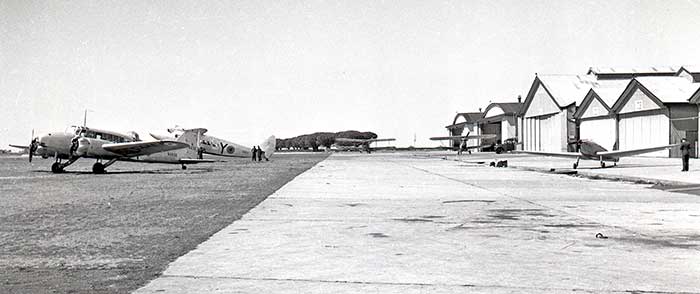
Ramp scene at RAAF Point Cook in 1941, showing impressed DH.86B A31-1 "Y" of 1FTS Signals School.
Also pictured L-R: Anson N4936, Avro Cadet, Hawker Demon, DH.94 Moth Minor Photo by Arch Dunne
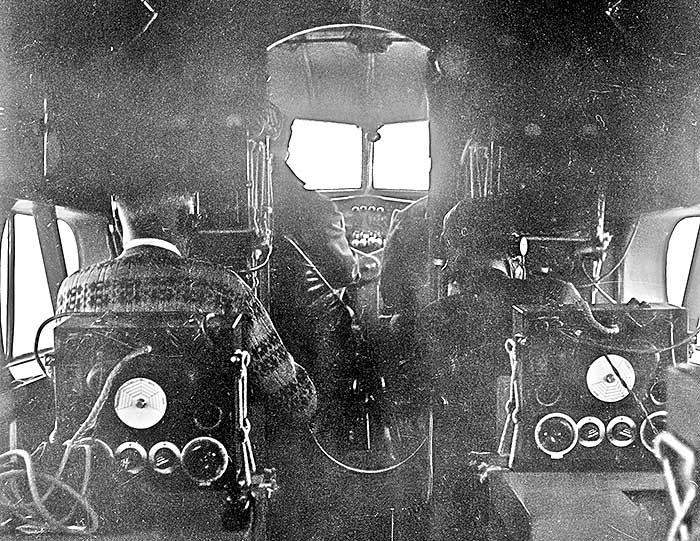
Cabin of a RAAF DH.86 radio trainer in flight from Point Cook in 1941. It is assumed that the two civilians
were radio technicians engaged to calibrate the W/T training equipment. Photo: Maurice Austin collection
were radio technicians engaged to calibrate the W/T training equipment. Photo: Maurice Austin collection
After the Japanese bombing of Darwin and other northern towns from February 1942, a second air ambulance unit, No.2 AAU, was established on 1 March 1942 to operate at home in the North West Area. Inital equipment was Tugan Gannets and later a variety of aircraft including several DH.86s. 2AAU moved base to Manbulloo NT but had detachments spread across a vast area of Australia from Exmouth on the west coast to Queensland.
In March 1942 three RAAF DH.86s were released temporarily back to Qantas to be used to supply the Buna/Bona campaign as the Japanese landed on the north coast of New Guinea. Two of these evacuated stranded civilians and soldiers from Mount Hagen in New Guinea, operated by QEA volunteers. The Department of Civil Aviation arranged to have several DH.86s released to Qantas to carry military supplies and personnel to the Darwin area, as well as maintaining some outback Queensland and NT domestic services.
By September 1944 the RAAF had no further use of DH.86s and the last two were made available for civil disposal from RAAF Amberley in Queensland. A31-4 was in poor condition and A31- 6 (loaned to QEA as VH-USF) damaged from a ground-loop. DCA offered A31-4 to QEA and Aircrafts Pty Ltd at Archerfield, who both declined due to the poor condition of the airframe and engines. In January 1945 the pair were listed by the Commonwealth Disposals Commission, and promptly purchased by MMA in Perth, which sent engineers to Amberly to make temporary repairs and ferried them to Perth.
RAAF No.1 Air Ambulance Unit was formed on 15 February 1941 at RAAF
Laverton near Melbourne. The primary function of the unit was
"transport of wounded and sick AIF personnel" and preparations
commenced for deployment to North Africa with the Western Desert
campaign. Initial equipment was three DH.86s transferred from
training duties at
1AOS at Cootamundra: A31-3, A31-4 and A31-7. However A31-4
was unserviceable
and was replaced by A31-8.
In April 1941 1AAU ground members sailed for the Middle East on board conveted troopship Queen Mary, followed in early May by DH.86s A31-3 and A31-7 flown to Egypt by 1AAU aircrew. They departed Australia at Drysdale Mission (Kalumburu) WA for the Timor Sea crossing. The long delivery flight was dogged by engine and instrument problems, crew illness, monsoonal weather in Burma and dust storms in Iraq before reaching Egypt in 98 hours flying time. A31-8 followed in August 1941.
At a conference at Middle East HQ the terms of 1AAU's operations were agreed. The unit would be issued with additional RAF and South African Air Force aircraft and crews, missions would be at the direction of the Middle East HQ Director of Medical Services under the operational command of the RAF. First base was Gaza, Palestine from where the first medical flight on 3 August was a DH.86 to Cyprus to collect three sick soldiers.
During October 1941 1AAU moved base to the operational areas, first Fuka then Gerawla where it was joined by A31-8 and a SAAF Lodestar. 168 patients were carried during November. On 8 December, there were three separate attacks on DH.86s by Luftwaffe fighters:
- Capt Nel's low altitude manouvres evaded being shot down by a group of Bf 109s at a forward Landing Ground
- Flg. Off. Bates had fighter bullet holes through the cabin and landed at LG 138, where RAF Hurricanes attacked the Luftwaffe fighters
- Flg. Off. Duffield in A31-8 was twice attacked near LG138, where he landed with the rear fuselage and port wing petrol tank on fire and some flying controls shot away. The DH.86 was a complete loss, a nursing orderly wounded and the pilot injured.
The two remaining RAAF DH.86s were damaged by enemy boming of El Adam airfield on 1 February 1942, A31-7 receiving considerable damage. They were moved to British Air Repair Unit at Heliopolis for repair. 1AAU was withdrawn to Egypt and leave granted. A31-3 did not return from Heliopolis, being destroyed while parked there by a RAF Beaufighter which ran off the runway on 19 April.
By October 1942 when General Montgomery led the British offensive in North Africa, 1AAU had been issued with 3 impressed RAF DH.86s, 2 SAAF Lodestars and even a RAF Grumman Goose, The unit moved with the Army to Alamein then Tunis, spending Christmas Day with RAAF No.3 fighter squadron at Marble Arch. By the end of 1942 1AAU had evacuated 2,003 patients of many nationalities. The unit was strengthened in 1943 with RAF Bristol Bombays fitted for 27 patients. In July 1943 1AAU was moved to Pachino, Sicily with 7 Bombays, 2 SAAF Lodestars - and two remaining DH.86s, A31-3 and HK843 which had been based in Malta.
During August 1943 1,646 patient were airlifted from Sicily and 74 from Tunisia. In September 1AAU moved to Reggio Calabria on mainland Italy. Changed policy on evacuating casualties in the Italian campaign reduced the usefulness of 1AAU and its obsolete aircraft. The 77 Octane fuel was unavailable for the DH.86s and the Bombays withdrawn. The Lodestars continued, flown by their SAAF crews.
1AAU operations ceased during November 1943. On 31 January 1944 while stationed at Bari, Italy the unit was instructed to transfer all equipment to store. Aircraft were issued to RAF repair and salvage units, the remaining DH.86 A31-7 handed over to the British Air Repair Unit at Heliopolis, Egypt on 25 February 1944. In April, 1AAU personnel sailed for Australia and the unit was disbanded on 27 June 1944.
Commanding Officers:
24.2.41 Flt. Lt. J. G. MacDonald
29.3.42 Flt. Lt. A.J. Duffield
20.10.42 Flt. Lt. J.P. Bartle
2.43 Flt. Lt. C.R. Broome AFC
DH.86 A31-3, A31-7, A31-8, AX762, HK829, HK843
Lodestar: 1371, 1378 (SAAF)
Bristol Bombay: L5810, L5820, L5825, N5827, L5829, L5831, L5838, L5839, L5842, L5844, L5845
Grumman Goose : HK822
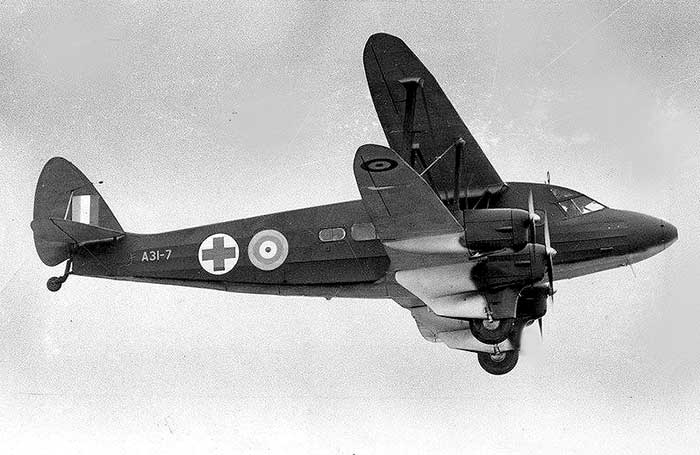
In April 1941 1AAU ground members sailed for the Middle East on board conveted troopship Queen Mary, followed in early May by DH.86s A31-3 and A31-7 flown to Egypt by 1AAU aircrew. They departed Australia at Drysdale Mission (Kalumburu) WA for the Timor Sea crossing. The long delivery flight was dogged by engine and instrument problems, crew illness, monsoonal weather in Burma and dust storms in Iraq before reaching Egypt in 98 hours flying time. A31-8 followed in August 1941.
At a conference at Middle East HQ the terms of 1AAU's operations were agreed. The unit would be issued with additional RAF and South African Air Force aircraft and crews, missions would be at the direction of the Middle East HQ Director of Medical Services under the operational command of the RAF. First base was Gaza, Palestine from where the first medical flight on 3 August was a DH.86 to Cyprus to collect three sick soldiers.
During October 1941 1AAU moved base to the operational areas, first Fuka then Gerawla where it was joined by A31-8 and a SAAF Lodestar. 168 patients were carried during November. On 8 December, there were three separate attacks on DH.86s by Luftwaffe fighters:
- Capt Nel's low altitude manouvres evaded being shot down by a group of Bf 109s at a forward Landing Ground
- Flg. Off. Bates had fighter bullet holes through the cabin and landed at LG 138, where RAF Hurricanes attacked the Luftwaffe fighters
- Flg. Off. Duffield in A31-8 was twice attacked near LG138, where he landed with the rear fuselage and port wing petrol tank on fire and some flying controls shot away. The DH.86 was a complete loss, a nursing orderly wounded and the pilot injured.
The two remaining RAAF DH.86s were damaged by enemy boming of El Adam airfield on 1 February 1942, A31-7 receiving considerable damage. They were moved to British Air Repair Unit at Heliopolis for repair. 1AAU was withdrawn to Egypt and leave granted. A31-3 did not return from Heliopolis, being destroyed while parked there by a RAF Beaufighter which ran off the runway on 19 April.
By October 1942 when General Montgomery led the British offensive in North Africa, 1AAU had been issued with 3 impressed RAF DH.86s, 2 SAAF Lodestars and even a RAF Grumman Goose, The unit moved with the Army to Alamein then Tunis, spending Christmas Day with RAAF No.3 fighter squadron at Marble Arch. By the end of 1942 1AAU had evacuated 2,003 patients of many nationalities. The unit was strengthened in 1943 with RAF Bristol Bombays fitted for 27 patients. In July 1943 1AAU was moved to Pachino, Sicily with 7 Bombays, 2 SAAF Lodestars - and two remaining DH.86s, A31-3 and HK843 which had been based in Malta.
During August 1943 1,646 patient were airlifted from Sicily and 74 from Tunisia. In September 1AAU moved to Reggio Calabria on mainland Italy. Changed policy on evacuating casualties in the Italian campaign reduced the usefulness of 1AAU and its obsolete aircraft. The 77 Octane fuel was unavailable for the DH.86s and the Bombays withdrawn. The Lodestars continued, flown by their SAAF crews.
1AAU operations ceased during November 1943. On 31 January 1944 while stationed at Bari, Italy the unit was instructed to transfer all equipment to store. Aircraft were issued to RAF repair and salvage units, the remaining DH.86 A31-7 handed over to the British Air Repair Unit at Heliopolis, Egypt on 25 February 1944. In April, 1AAU personnel sailed for Australia and the unit was disbanded on 27 June 1944.
Commanding Officers:
24.2.41 Flt. Lt. J. G. MacDonald
29.3.42 Flt. Lt. A.J. Duffield
20.10.42 Flt. Lt. J.P. Bartle
2.43 Flt. Lt. C.R. Broome AFC
DH.86 A31-3, A31-7, A31-8, AX762, HK829, HK843
Lodestar: 1371, 1378 (SAAF)
Bristol Bombay: L5810, L5820, L5825, N5827, L5829, L5831, L5838, L5839, L5842, L5844, L5845
Grumman Goose : HK822

A31-7
in No.1AAU camouflage markings prior to departure for
Egypt.
Photo: The Collection
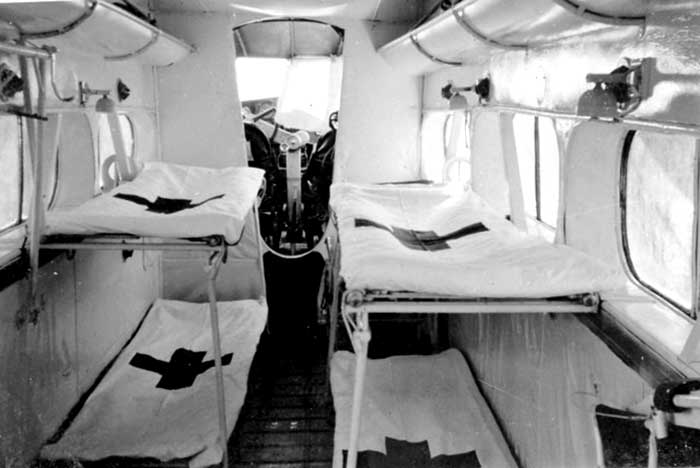
RAAF DH.86 cabin fitted out as an aerial ambulance
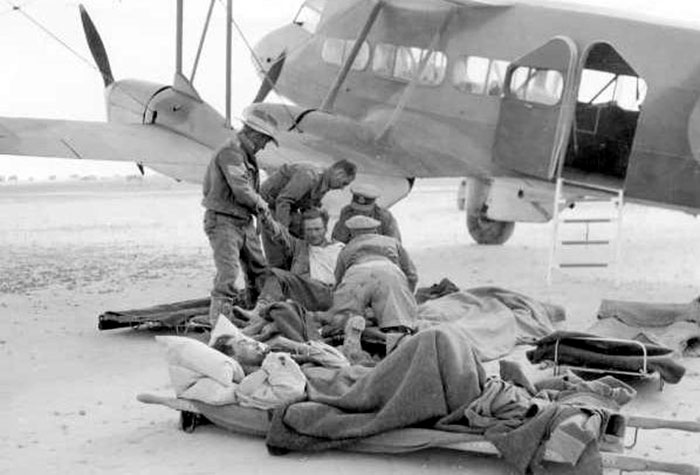
A31-7 loading casualties during the Western Desert campaign
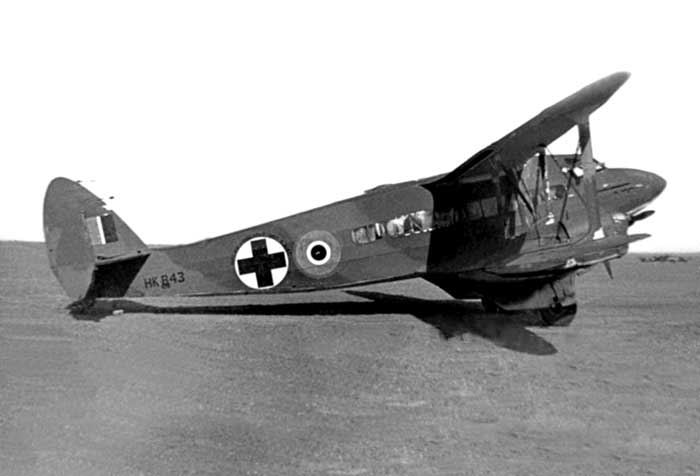
HK843
was one of three RAF DH.86s operated by
1AAU
Photo: The Collection
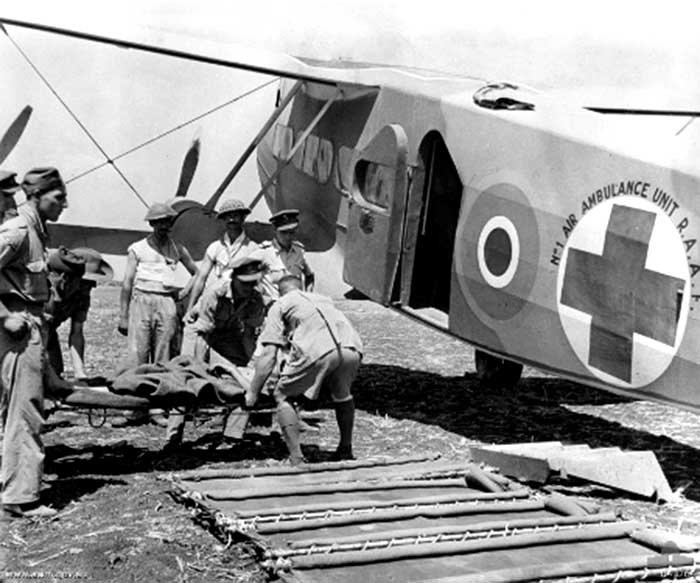




RAF
DH.86 in service with 1AAU. Note the roof observation dome
modification.
The Collection
Within DCA there was considerable concern over the unexpected development of DH.86s continuing in airline service after the war, given the continuing doubts over the type’s airworthiness. However because there was no specific airworthiness issue outstanding, the Department could raise no formal objection to MMA putting the type back into airline service. Because of the company’s pre-war experience with DH.86s there was an acceptance that MMA would be a satisfactory operator of the type. Sadly the concerns were promptly justified on 24 June 1945 when VH-USF suffered a fatal crash at Geraldton WA on its very first airline service - one day after DCA renewed its CofA following the post-RAAF overhaul in Perth. The very experienced Captain, who had flown MMA DH.86s pre-war and one passenger were killed and the other 9 on board were injured. Witness reports indicated a loss of control as soon as the aircraft was airborne, prior to an abnormal landing and crash.
Despite this, an apparently rushed DCA investigation laid the blame on the deceased Captain. Australian aviation accident investigator Macarthur Job, in his book Air Crash Volume 2 sums up:
"With hindsight, it seems that the unfortunate Captain Branch was harshly judged. Just what went wrong with VH-USF after takeoff from Geraldton can only remain a matter of speculation, but all evidence points to the onset of a major control problem.
Indeed, considering the fact that five Australian DH.86s were destroyed in mysterious fatal accidents that all pointed to a loss of control, VH-USF's nine survivors probably had a narrow escape, very likely owing their lives to Captain Branch's valiant efforts in maintaining the limited measure of control that he did."
Meanwhile, MMA's second post-war DH.86 VH-USW was put into service and soon was a cause for worry. MMA Chief Pilot Captain James Woods reported difficulty controlling the aircraft which dived and shuddered in flight near Carnarvon. He was able to land safely, when the cause was found to be an undercarriage cowling detaching and becoming wrapped around the tailplane. Woods suggested to DCA that this could have been a possible cause of the 1930s loss of control accidents. Apart from a flury of memos within the Department, no further action was taken prior to the good news that MMA had managed to secure a sale for VH-USW to an English charter company.
Not even this final act of the MMA DH.86 saga was without drama. VH-USW departed Perth in November 1946, flown by a British ferry crew. The pair departed in high spirits but while flying across India, a tail flutter increased in severity until they declared the aircraft dangerous. They abandoned it at Allahabad, left it parked in the open where it became derelict, still wearing its Australian registration VH-USW. To DCA's chagrin they later become entangled in British legal action taken against the ferry company when it became clear that it was delivered under its Australian certification, which had in fact been cancelled when the aircraft departed Australia.
One final unexpected DH.86 in Australia
A year after DCA sighed with relief at the end of the DH.86s in Australia, A British registered DH.86 G-ADYH was to arrive in Australia in November 1947. It had been purchased in England by Australian aviation adventurer Captain H.W.G. Penny, founder of Intercontinental Air Tours, Sydney. Warren Penny used it alongside ICAT’s Lockheed Hudson and Lodestar on charter flights bringing migrants to Australia from England and Southern Europe. Penny was experienced on the DH.86, having flown them pre-war for Union Airways in New Zealand, and while he was England in 1947 heard that G-ADYH was available at low cost at an auction sale.
The reaction of the migrants, who had paid high charter fares to secure air passage to Australia, only to find themselves and their families boarding a biplane at Rome or Athens is not recorded.
G-ADYH first arrived at Mascot Airport, Sydney on 28 November 1947 from London via all stops, carrying ten British, Greek and Italian migrants. This DH.86 made further return flights to Rome to collect migrants until February 1948, when Warren Penny found himself financially unable to continue. In a deal to have his oustanding paid-up migrants in Europe collected by another operator, G-ADYH's ownership was transferred to an American mercenary pilot who was flying a Philippines-registered DC-3 on the Australian migrant charters. It was then based in Malaya and Burma, flying for Sukarno’s Indonesian independence rebels to support their military actions against the Dutch in the Netherlands East Indies. (Refer to The Migrant Caper on this site for a detailed account of these events)
DH.86 c/n 2307 RMA Canberra VH-USC, A31-5, VH-USC
| 8.34 |
Built at Hatfield by De Havilland Aircraft Co Ltd First aircraft completed of the Qantas order for five DH.86s with two-pilot cockpit |
| 1.8.34 |
Australian Civil Aviation Branch allocated registrations VH-USC to -USG to the Qantas DH.86s. Australian registration was painted on the airframe at the DH factory |
| 1.9.34 |
Added to Civil Register as VH-USC: Qantas Empire Airways Ltd, Brisbane Qld. |
| Named RMA Canberra |
|
| 24.9.34 |
VH-USC departed Croydon Airport, London for Australia, under command of QEA
Chief Pilot Captain Lester J. Brain. First Officer R. U. Price and engineer R. A. Pink. Carried a spare DH Gipsy Six engine tied down in the cabin. |
| 13.10.34 |
Arrived Archerfield Aerodrome Brisbane, which was QEA's base. First DH.86 to be delivered. |
| 26.10.34 |
Inspection report at Archerfield after preparation for Australian CofA. Airframe time 113 hrs |
| 28.10.34 |
Test flight Archerfield after inspection, Captain L. J. Brain |
| 22.1.35 |
Official issue of Australian CofA |
| 25.3.35 |
VH-USC departed Brisbane for Darwin on the first QEA DH.86 service to Singapore |
| 26.2.35 |
Departed Darwin at dawn on the first QEA DH.86 service to Singapore,
replacing Imperial Airways which had temporarily operated
Singapore-Darwin while the Australian DH.86s were grounded. QEA
Captains G. U.
Allan and W. H. Crowther. Arrived at Kallang Aerodrome, Singapore on 28 Februaery 1935 |
| 35 |
In regular use on the Brisbane-Singapore route. Numerous incidents and minor damage, usually due to poor airfield surface |
| 26.6.35 |
QEA letter to CAB advising that flaps had been retrospectively fitted to their DH.86s VH-USC, USD, USE, USF & UUA |
| 6.1.36 |
Annual CofA renewal completed at Archerfield. Test flown same day by QEA Captain R. B. Tapp. Airframe time 801 hrs. |
| 11.1.36 |
Badly damaged at Kallang Aerodrome, Singapore. While landing in heavy rain, aircraft skidded on surface water and over-ran the airfield boundary and after slowing to 10 knots struck the light railway line. Starboard undercarriage and wing damaged. Captain R. B. Tapp and two passengers uninjured |
| 31.3.36 |
Test flown Singapore after repairs, pilot QEA Captain W.H.Crowther |
| 19.3.37 |
Tipped on nose while taxying after landing at Cloncurry Qld when the main wheels became bogged in soft ground. The undercarriage collapsed, nose and props damaged. Captain H. B. Hussey and 5 passengers unhurt. Temporary repairs at Cloncurry, ferried to Archerfield |
| 13.4.37 |
Test flown Archerfield after full repair completed, Captain R.S.Adair. Airframe time 2,265 hrs |
| 15.4.37 |
Damaged when a mailbag was dropped from the aircraft at
Brunette Downs Station. The bag was dropped from a hatch in the rear cabin floor but was blown on to the port horizontal
tailplane and damaged the elevator. Captain R. S. Adair and 5 passengers unhurt |
| 21.3.38 |
Annual CofA renewal completed Archerfield. Test flown same day by QEA Captain C. R. Gurney. Airframe time 3,640 hrs. |
| 22.7.38 |
Change of ownership: MacRobertson Miller Aviation Co Ltd, Perth WA Retained the name RMA Canberra in MMA service |
| 7.38 |
Purchase contract included VH-USC & VH-USD, 7 spare Gipsy Six engines, spares stock and tools |
| 23.7.38 |
VH-USC delivered to Perth from Darwin, Captain James Woods and Captain Frank Cooper |
| The
QEA DH.86s were available for disposal because they had been replaced
by Short S.30 Empire flying boats on the Brisbane-Singapore-Brisbane
Empire Air Mail route. MMA purchased VH-USC & VH-USD to fill the gap before their ordered Lockheed 10A Electras entered service. They were used on the MMA Perth-Darwin route, which was scheduled to connect with the QEA Short Empire flying boat at Darwin. Each MMA DH.86 departed Perth or Darwin at the same time on a twice-weekly schedule, carrying the air mail to/from Darwin, via various intermediate ports |
|
| 7.38 |
In MMA service VH-USC |
| 29.7.38 |
MMA pilot William Anderson logbook: while flying MMA DH.84s Perth-Daly Waters-Perth: 29-30.7.38: Second pilot on USC Noonkenbah-Pt Hedland-Perth 19-21.1.39: Captain on VH-USC Wyndham-Darwin-Port Hedland-Perth. From then on he flew MMA Lockheed 10s Perth-Darwin |
| 1.8.38 |
Inaugural MMA DH.86 service departed Perth for Darwin. Captain Frank Cooper and F/O Jim Branch, |
| 1.39 |
Tailwheel shock-strut assembly failed during a request landing at Wallal Station WA
while operating a northbound scheduled service to Darwin. MMA
chief engineer Frank Colquhoun and two mechanics arrived at Wallal on
VH-USD, and the tailwheel of VH-USD was fitted to VH-USC to allow it to
continue the northbound service |
| 11.4.39 |
Annual CofA renewal completed by MMA at Maylands Aerodrome, Perth. Test flown same day by Captain F. H. Cooper. Airframe time 5425 hrs. |
| 11.39 |
Total airframe time 6,166 hours. 2000 hours flown by MMA |
| 1.40 |
Reserve aircraft with MMA, flew only 743 hours until 9.40 when impressed for RAAF |
| 20.5.40 |
DCA inspection report at Maylands WA: airframe time 6655 hours |
| 6.7.40 |
Impressment Requisition No.8176 issued to MMA
for VH-USC: to be handed over to Commonwealth Government for issue to RAAF |
| 25.7.40 |
DCA inspection report at Maylands WA for assessment of value to be paid as compensation for impressment |
| 13.9.40 |
Brake failure while taxying at Wyndham, no damage. Captain H. J. Branch, 6 passengers |
| 24.9.40 |
Impressment Requisition: VH-USC to be delivered to Melbourne by MMA and handed over to CO 3EFTS Essendon |
| 29.9.40 |
Departed Maylands on delivery to RAAF at Esendon, flown by MMA Chief Pilot Captain James Woods |
| 30.9.40 |
Taken on RAAF charge as DH.86A A31-5. Received at 3EFTS Essendon ex MMA. Overhaul and RAAF modifications to be carried out by Ansett Airways at Essendon |
| 1.11.40 |
Inspection Report at Essendon after modifications for RAAF training. Airframe time 7091 hrs |
| 8.1.41 |
A31-5 serviceable at ANA Essendon. Allotted to 1Air Observers Sschool at Cootamundra NSW |
| 13.1.41 |
Serviceable at 1AOS at Cootamundra |
| 3.42 |
Due lack of RAAF transport capability, DCA negotiated an agreement for RAAF to loan the former VH-USC,
USF & USW to Qantas Empire Airways to operate military charter flights to
Darwin areas and New Guinea flown by civil QEA pilots |
| 3.42 |
A31-5 issued to Qantas ex 1AOS Cootamundra |
| 26.3.42 |
Restored to Register VH-USC Department of Civil Aviation, for use by Qantas Empire Airways Ltd |
| 26.3.42 |
CofA renewed |
| The initial task by QEA was to evacuate civilians trapped by Japanese advances at Mount Hagen
in the New Guinea highlands. VH-USC & USF had
long-range fuel tanks and altitude controls fitted for flights over the
12,000 feet mountains to reach Mount Hagen. VH-USW could not be used and was returned to RAAF |
|
| 10.5.42 |
Forced landing near Townsville Qld on open land, no damage. A fuel blockage
caused both port engines to fail. Captains Orm Denny and Rex Nicholl
were ferrying VH-USC from Brisbane to Horne Island, carrying two QEA
engineers as passengers. The crew rectified the problem, took off and
landed at the main Townsville aerodrome, which included RAAF Station Garbutt.
The DCA Forced landing report quoted “Charter flight to New Guinea” |
| 13.5.42 |
VH-USC & USF took off from Horn Island at 7am to commence the
evacuation of Mount Hagen. Both
aircraft operated from Horn Island jujst off the tip of Cape York Qld, flying
across New Guinea through difficult weather and under threat from
Japanese aircraft. The operation was completed on 24.5.42 when 86
civilians and soldiers had been flown to safety from Mount Hagen. The two DH.86s were operated by QEA volunteers Captains Orm Denny, Eric Sims, Rex Nicholl, radio operators F. S. Furniss, R. J. Anderson, L. W. Louttit and engineers D. E. Chambers and R. G. Carswell. |
| 6.42 |
VH-USC & USF were now
operated by QEA on military charters as directed, mostly to Darwin and
Batchelor NT, carrying personnel and supplies |
| 9.9.42 |
CofA renewed after inspection at Archerfield |
| 24.10.42 |
Inspection at Archerfield on return from a military charter found that the “front anchoring” of the tail fin was insecure. The fin was removed, revealing that the wooden glue joints had failed. DCA investigation found that this fin had been attached to VH-USC for 8 years |
| 30.10.42 |
Blown on nose by a wind squall while parked at
Cloncurry Qld. Captain O.F.Y. Thomas. The passenger steps damaged the under surfaces of the rear fuselage. Temporary repairs overnight and flown to Archerfield next day |
| 11.11.42 |
Port lower wingtip damaged when struck a hangar while taxying at Longreach Qld. Captain H. B. Hussey & F/O H. G. Mills. |
| 11.42 |
QEA submitted the cost of repairs for damage incurred on 30.10.42 & 11.11.42 to DCA for reimbursement by the Government, because the aircraft was owned by RAAF |
| 13.12.42 |
VH-USC & USF began a series of supply-dropping flights from Port Moresby to the Australian Army troops at the Buna ground battle area on the north coast of New Guinea |
| 1.43 |
After military charters in
New Guinea, VH-USC & USF were based Archerfield and used by QEA on
military charters to Darwin area and also on their western
Queensland civilian routes |
| 19.4.43 |
Returned to Archerfield after departure, due electrical fault. No damage. Captain G. Morgan Forced Landing report states: Scheduled service Brisbane-Batchelor. |
| 13.5.43 |
Returned to Archerfield after departure due engine fault. No damage. Captain G. Morgan, with 8 passengers. Forced Landing report states: Charter flight Brisbane-Darwin. |
| 1.10.43 |
An eagle struck the tailplane in flight near Roma Qld, aircraft landed safely at Roma. Captain I. J. Hosie. To repair VH-USC’s damaged tailplane, the rudder and bracing wires from VH-USF were fitted because at the time USF was u/s at Roma undergoing maintenance by QEA engineers. Forced Landing report states: Scheduled flight Brisbane-Batchelor. |
| 13.10.43 |
Swung violently on landing Archerfield, starboard undercarriage collapsed, seriously damaged. Flight DA178M, arriving from Darwin, Captain D.A.Tennent. Accident report states: DAT Charter. (Directorate of Air Transport, Allied Air Forces supervised military loadings by civil aircraft until 1944) |
| 1.11.43 |
Repairs completed at Archerfield |
| 29.1.44 |
Returned to Archerfield after departure due to an engine cowling coming
loose in flight, no damage. Captain E.Morton with 7 passengers. Forced
Landing report states: Scheduled flight Brisbane-Darwin. |
| 22.6.44 |
Inspection report at Archerfield, airframe time 11,815 hrs |
| 9.10.44 |
Crashed on landing Darwin NT. Captain D.A.Tennent landed on a
crosswind strip because the main runway was closed for maintenance. Ran
off the strip into a ditch. No injuries, but major damage to the undercarriage and lower wings. |
| RAAF Status Card A31-5: Crashed Darwin while on loan to DCA for use by QEA. Aircraft badly damaged. RAAF North West Area to arrange salvage and submit survey report | |
| 16.10.44 |
RAAF Status Card: Conversion to components recommended by area engineering officer. 4 Repair & Salvage Unit, Pell Field, Darwin to collect and deliver to 8 Central Recovery Depot, Darwin |
| 17.10.44 |
RAAF Status Card: Request NWA arrange for immediate issue of all seats from this aircraft to DCA representative at Darwin |
| 6.1.45 |
RAAF Status Card: Approved for conversion to components. |
| Airframe total time: 11,664 hours |
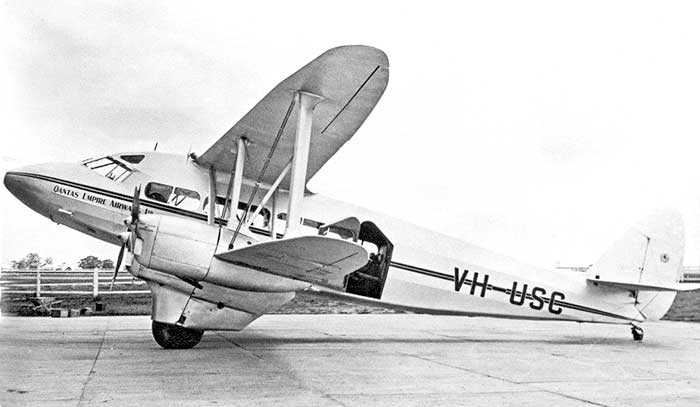
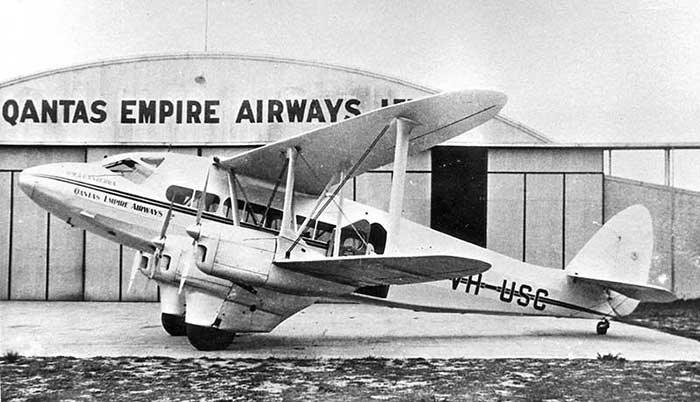
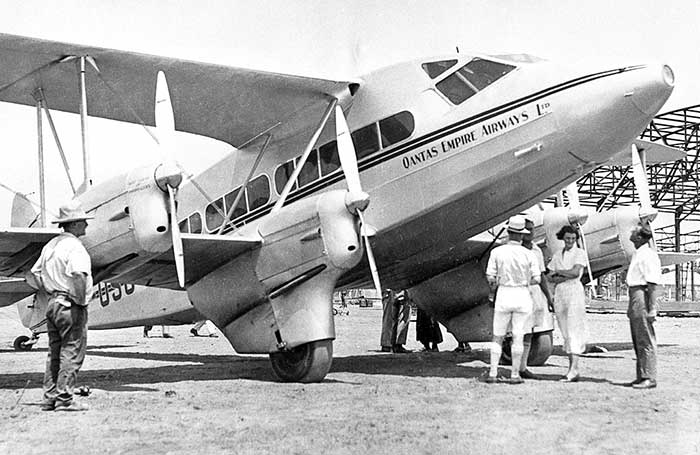
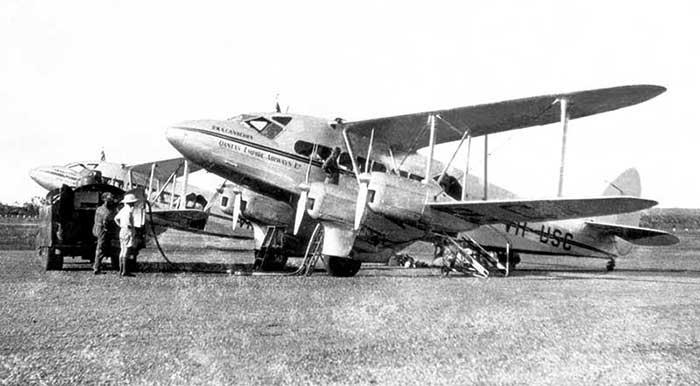
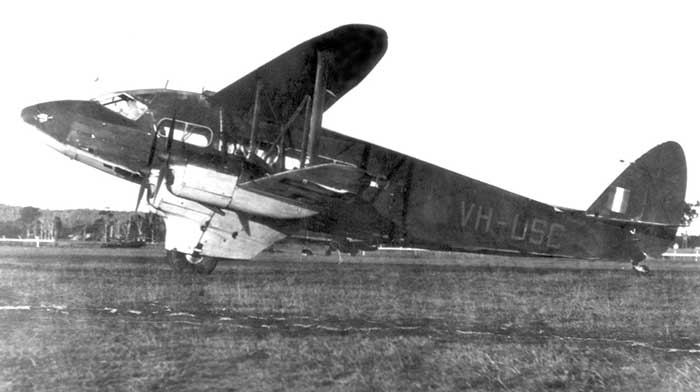
| 7.34 |
Built at Hatfield by De Havilland Aircraft Co Ltd. First production DH.86, single pilot cockpit. Not fitted with flaps |
| 3.34 |
Ordered by Tasmanian Aerial Services Pty Ltd, Launceston, Tasmania To replace DH.84 Dragons on Tasmania-Melbourne airline services |
| 8.34 |
Shipped to Australia as crated cargo on board SS Baradine |
| Company reformed 9.34 as Holyman’s Airways Pty Ltd, Launceston, Tasmania | |
| 10.9.34 |
Arrived Port Melbourne |
| Assembled at RAAF Laverton Vic |
|
| 9.34 |
First flown Laverton after assembly, pilot Alan Murray Jones of De Havilland Aircraft Pty Ltd, Sydney |
| 27.9.34 |
Added to Register VH-URN: Holyman’s Airways Pty Ltd, Launceston Tas |
| 27.9.34 |
Australian CofA issued, seating for 12 passengers |
| 28.9.34 |
Trial flight Laverton-Launceston in a record time of 1hr 50 mins. Returned to Laverton |
| 1.10.34 |
Ferried Laverton-Hobart by HAL Captain Ken Frewin, in prepation to commence scheduled airline services between Tasmania and Melbourne |
| 2.10.34 |
Named Miss Hobart in a ceremony at Western Junction Aerodrome, Launceston by the Governor of Tasmania, Sir Ernest Clark |
| 3.10.34 |
VH-URN flew its inaugural
scheduled airline service Launceston-Melbourne. Holyman Airways had
permission to initially use RAAF Laverton as their Melbourne terminal
because of doubts that Essendon's size was adequate for a fully loaded
DH.86 with passengers. Captain Ken Frewin flew this first service, passengers included the Assistant Minister for Defence. It was a slow trip against headwinds and Frewin elected to land at RAAF Point Cook, only several miles prior to Laverton due to critically low fuel. |
| 19.10.34 |
Lost without trace at sea in Bass Strait off Wilson Promontory Victoria. Last radio report in vicinity of Wilson’s Promontory on a scheduled flight from Launceston direct to Essendon Airport, Melbourne. Under command of Chief Pilot Captain Gilbert Jenkins, with the airline's co-founder, Captain Victor Holyman as copilot/radio operator. They and the nine passengers were lost. |
| 19.10.34 |
Initial air search carried out by Hart Aircraft Service Desoutter VH-UPR from Essendon |
| 21.10.34 |
A searching RAAF Supermarine Southampton flying boat from Point Cook sighted aircraft wreckage floating on water but no further sightings |
| 18.11.34 |
A passenger chair from VH-URN was found washed ashore at Waratah Bay, near Wilsons Promontory |
| Speculation
at the time suggested that Captain Holyman may have been changing over
with Jenkins in the single seat cockpit, a difficult manoeuvre, during
which control was lost |
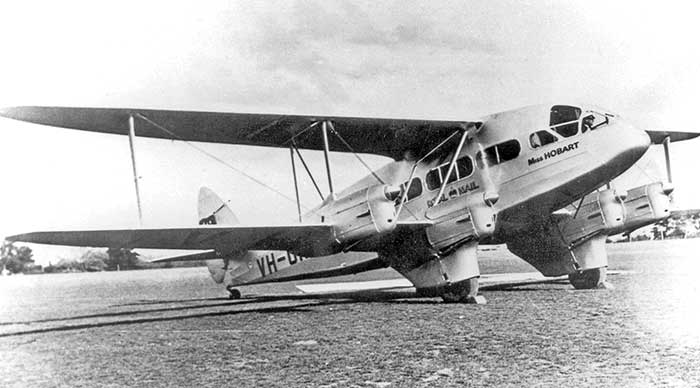
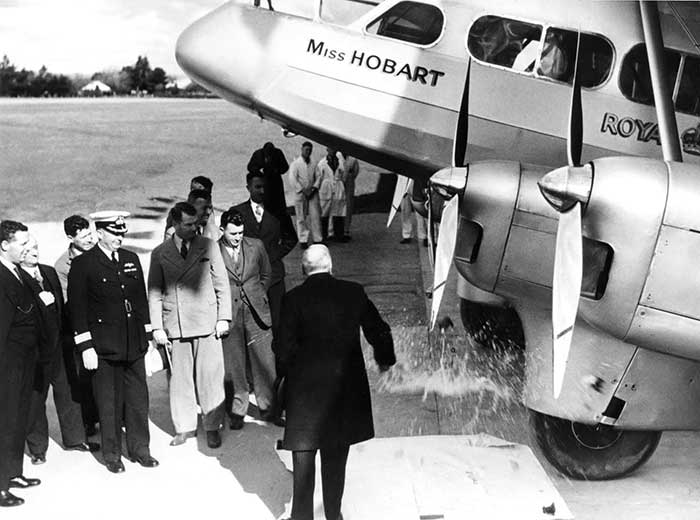
Sir Ernest Clark breaks the champaign bottle. CAHS Macarthur Job Collection
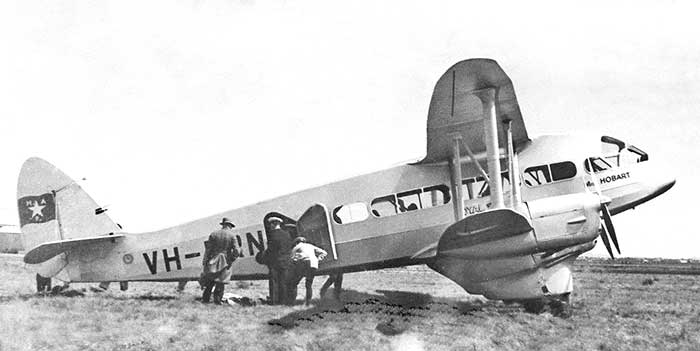
| 9.34 |
Built at Hatfield by De Havilland Aircraft Co Ltd. Production DH.86 |
| Australian Civil Aviation Branch had allocated registrations VH-USC to -USG to the Qantas DH.86s. Australian registration was painted on the airframe at the DH factory |
|
| 24.9.34 |
British CofA issued as VH-USD |
| Shipped to Brisbane as cargo on board SS Bendigo | |
| 12.11.34 |
Ship arrived Brisbane |
| 17.12.34 |
Weighed at Archerfield Aerodrome, Brisbane after assembly. Airframe time 1 hr 35 min |
| 9.1.35 |
First test flight at Archerfield |
| 22.1.35 |
Added to Civil Register VH-USD: Qantas Empire Airways Ltd, Brisbane Qld. |
| Named RMA Brisbane |
|
| 22.1.35 |
Australian CofA issued |
| 24.1.36 |
Annual CofA renewal inspection completed at Archerfield. Test flown that day by Captain L. J. Brain. Airframe time 751 hrs |
| 20.1.37 |
Annual CofA renewal inspection completed at Archerfield. Test flown that day by Cpt H. B. Hussy. Airframe time 2049 hrs |
| 7.11.37 |
Badly damaged at Darwin NT. During takeoff at 5.20am, the port inner engine failed, causing the pilot to abort the takeoff and deliberately ground-loop the aircraft to avoid hitting the airfield boundary fence. Undercarriage collapsed. Captain E. C. Sims and First Officer J. L. Grey. No injuries. |
| 27.11.37 |
Test flown Darwin by Captain R. Sheppard after repairs. Airframe time 3154 hrs |
| 28.7.38 |
Change of ownership: MacRobertson Miller Aviation Co Ltd, Perth WA Retained name RMA Brisbane in MMA service |
| 7.38 |
Ferried Darwin-Peeth by MMA Captains James Woods & Alex Whitham |
| Purchase contract included VH-USC & VH-USD, 7 spare Gipsy Six engines, spares stock and tools | |
| The QEA DH.86s were available for disposal because they had been
replaced by Short S.30 Empire flying boats on the
Brisbane-Singapore-Brisbane Empire Air Mail route. MMA purchased VH-USC & VH-USD to fill the gap before their ordered Lockheed 10A Electras entered service. They were used on the MMA Perth-Darwin route, which was scheduled to connect with the QEA Short Empire flying boat at Darwin. Each MMA DH.86 departed Perth or Darwin at the same time on a twice-weekly schedule, carrying the air mail to/from Darwin, via various intermediate ports |
|
| 5.8.38 |
MMA pilot William Anderson log book while he was flying MMA DH.84s Perth-Daly Waters-Perth: 5-6.8.38 Second pilot on VH-USD Perth-Port Hedland-Noonkenbah Station WA |
| 16.11.38 |
Right main undercarriage collapsed in a
severe ground-loop when landing with a flat tyre at Fitzroy Crossing WA. Damage to wings, engines, interplane struts and undercarriage. Captain H. J. (Jim) Branch, First Officer Hec White and two passengers unhurt. |
| 11.38 |
Temporary repairs were carried out at Fitzroy Crossing over two
weeks in 45C heat by MMA Chief Engineer Frank Colquhoun with MMA staff from Perth: metalworker Bill Bland and woodworker Jack Hopkins, assisted by the stranded pilots. |
| 11.38 |
Ferried south to Perth for permanent repairs by MMA at Maylands |
| 7.12.38 |
Test flown at Maylands on completion of full repair, flown by Captain Jim Branch. Airframe time: 4,704 hrs |
| 6.1.39 |
Left main undercarriage collapsed during a ground-loop on landing at Derby WA on the Seven Mile Marsh strip. Captain Alex Whitham, First Officer Colin Browne and 6 passengers unhurt. |
| 1.39 |
Temporary repairs were carried out over two weeks at the airstrip by the same three MMA maintenance men from Perth as the Fitzroy Crossing accident two months earlier with help from the two pilots. They were tormented by bush flies, marsh flies, mosquitoes and heat exposure. The outer wings and engines were removed, the damaged wing sections repaired in town in a covered workshop |
| 1.39 |
Ferried to Perth for permanent repair, flown by Whitham and Browne. MMA Perth cabled an instruction to land at Wallal Station WA where the northbound VH-USC had damaged its tailwheel shock-strut assembly. The serviceable tailwheel assembly from USD was to be installed in USC to allow it to depart for Darwin with its passengers and airmail. Rather than a long wait for replacement parts from Perth before USD could continue south, the repair crew fashioned parts using the station blacksmith shop and scrap heap. VH-USD departed Wallal next afternoon for Perth. |
| 1.39 |
Sold to Tata & Sons Ltd, Bombay, India. MMA to deliver the aircraft to Bombay |
| 23.2.39 |
Departed Perth on ferry flight from Perth to India by MMA Chief Pilot Captain James Woods and First Officer Clive Foreman. Woods’ wife Mollie went along as a passenger. A spare Gipsy Six engine which had been sold to Tata & Sons was carried in the cabin |
| 2.39 |
On takeoff from Broome WA, starboard inner engine failed and the aircdaft struck a tree with only minor fabric damage. Flew to Nookenbah Station where the engine and fabric were rectified |
| 26.2.39 |
Struck-off Australian Register |
| 4.3.39 |
Arrived at Bombay on delivery |
| 9.3.39 |
Formal change of ownership: Tata & Sons Ltd Aviation Department, Bombay |
| 3.39 |
Registered VT-AKZ: Tata & Sons Ltd Aviation Department, operated by Tata Airlines |
| 21.6.40 |
Impressed in India for issue to RAF, serial AX800 Allotted to No.1 Service Flying Training School, Ambala, India |
| 4.41 |
Reportedly based Juhu, India with No.2 Coastal Defence Flight. Modified to carry two 250lb anti-submarine bombs |
| .41 |
Issued to No.5 Coastal Defence Flight based Wilmingdon island, Cochin, India |
| 18.12.41 |
Damaged on takeoff at Ahmedabad on a ferry flight to Bombay. Aircraft developed an uncontrollable swing, port undercarriage collapsed |
| Struck-off RAF charge as Category B damage | |
| 1.9.43 |
Restored to Civil Register VT-AKZ Department of Civil Aviation, Bombay Probably operated again by Tata Airlines |
| 20.11.44 |
Struck-off Indian Civil Register |
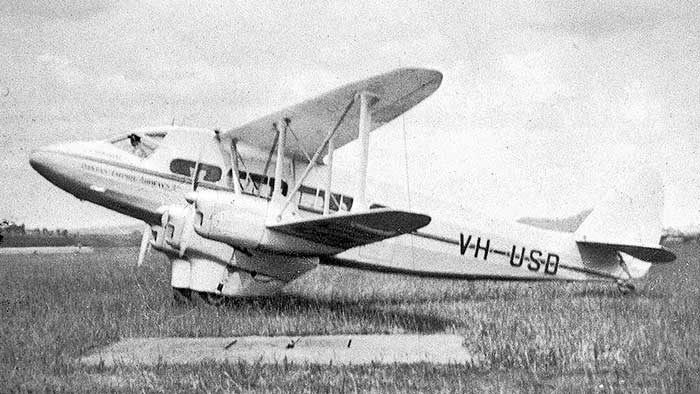
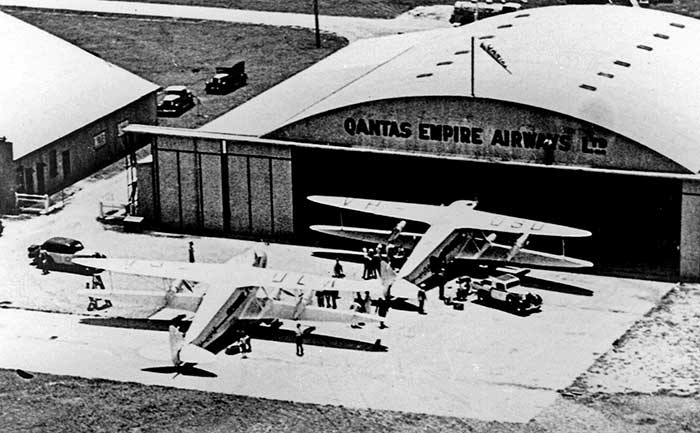
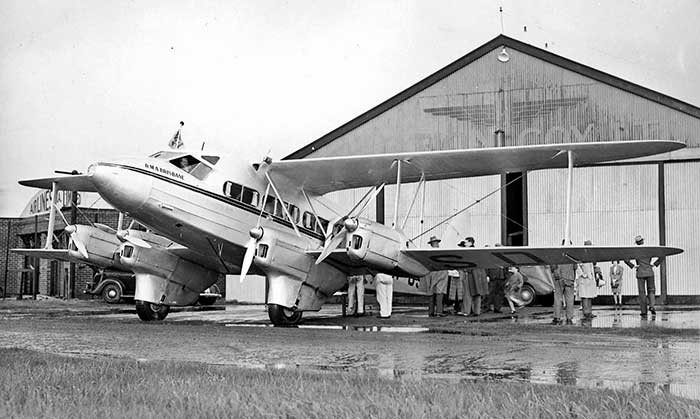
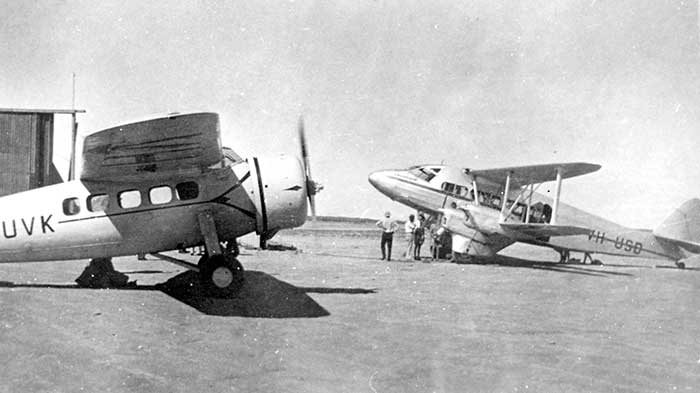
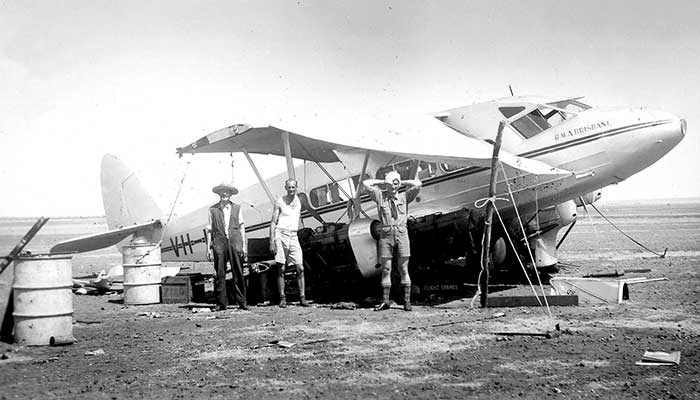
removed and a tarpaulin rigged to provide some shade from the oppressive heat. Photo by Frank Colquhoun
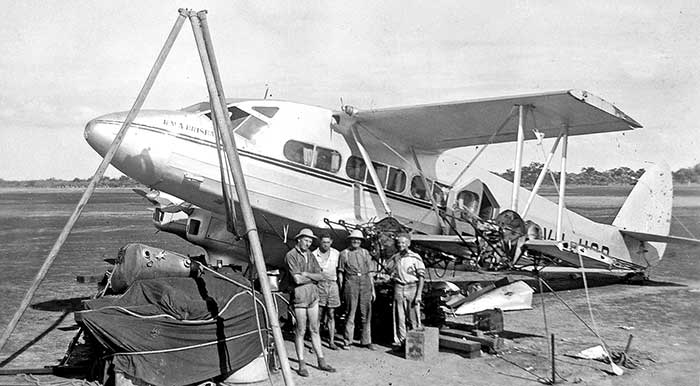
| 9.34 |
Built at Hatfield by De Havilland Aircraft Co Ltd. Production DH.86 |
| Australian Civil Aviation Branch had allocated registrations VH-USC to -USG to the Qantas DH.86s. Australian registration was painted on the airframe at the DH factory |
|
| 2.10..34 |
British CofA issued VH-USE: Qantas Empire Airways Ltd, Brisbane Qld |
| Shipped to Australia, assembled by QEA at Archerfield Qld | |
| 22.1.35 |
Added to Register VH-USE: Qantas Empire Airways Ltd, Brisbane Qld |
| 22.1.35 |
Test flown Archerfield after assembly, pilot Captain L.J. Brain |
| 22.1.35 |
Australian CofA issued |
| 23.1.35 |
CAB Inspection Report at Archerfield. Airframe total time 1 hr 5 mins |
| 3.8.35 |
RMA Sydney covered the Koepang–Singapore section in record time of 12 hours 10 minutes, an average speed of 149.7mph |
| 27.4.36 |
Badly damaged on landing at Sourabaya NEI.
Starboard tyre burst on touchdown, tyre came off rim and aircraft sank
in soft ground and swung violently on the starboard undercarriage. Tail
lifted off ground then fell back, damaging fuselage longerons. Captain
R.B.Tapp and three passengers unhurt. Relief aircraft sent from Darwin to collect passengers and airmail. |
| 8.8.36 |
Repairs completed at Sourabaya by QEA engineer J.G.Beohm. |
| 12.8.36 |
Ferried to Singapore |
| 3.11.39 |
DCA inspection report at Archerfield for assessment of availability for impressment. Airframe total time 5527 hrs. |
| 6.7.40 |
DCA wrote to QEA advising that it is not anticipated that VH-USE will be impressed for RAAF at this time |
| 11.40 |
VH-USE is the only remaining Qantas DH.86, used on Queensland inland services |
| 20.2.41 |
Inspection report at Archerfield, excellent condition. Total airframe time 7221 hrs |
| 20.2.42 |
Crashed destroyed near Belmont, Mount Petrie, 9 miles NE of
Brisbane Qld. Departed Archerfield at 8.29am. Location also referred to as Capalaba Qld The tailplane had broken away in flight and was found some distance from the rest of wreckage. Captain C.H.C.Swaffield, First Officer and 7 passengers killed. |
| 27.2.45 |
DCA Memo regarding cause of crash states it was clearly structural failure in flight: “Examination of the damaged fin shows there is definite weakness regarding the design of the fin post. A modification was sent to RAAF because there were no civil DH.86s remaining on the Civil Register at this time. When VH-USC, USF, USW were transferred from RAAF to QEA shortly afterwards, they were checked that they had modified fins. QEA also modified their spare fin held in storage.” |
| Respected aviation accident investigator Macarthur Job later wrote in his book Air Crash Vol.2: "Taking place little more than 24 hours after the highly destructive first Japanese air raid on Darwin, news of this DH.86 crash was overwhelmed by the nation's almost total preoccupation with the first air raid on Australia soil. As a result, what in other circumstances would have been regarded as a major disaster, hardly rated a mention in the national press. The intended DCA investigation fared little better, the wreckage having been deliberately burnt by the time Senior Aeronautical Engineer J. L. Watkins arrived from DCA Central Office in Melbourne to examine it. The nine victims had died in vain; no cause could be established and no lesson learnt from it that might have rendered operations safer in the future. Only the aircraft's fin - found almost a mile from the main wreckage - bore any witness to what had befallen the aircraft and its occupants, clearly attesting to the fact that the machine had somehow broken up in flight. But beyond adding further uneasiness to the already dubious reputation of the DH.86 as a type, the accident contributed nothing to the progress of Australia's airways safety." |
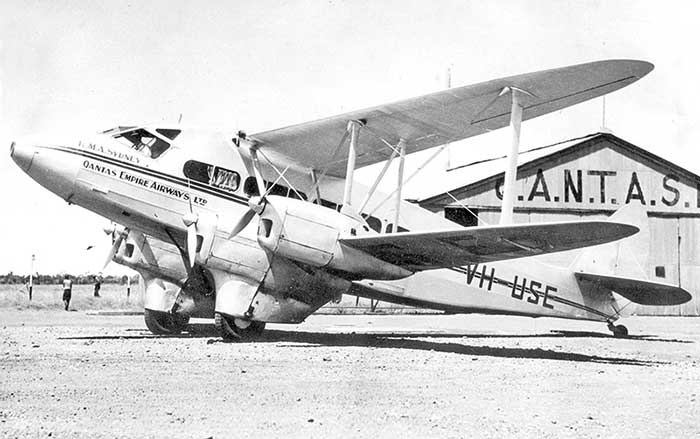
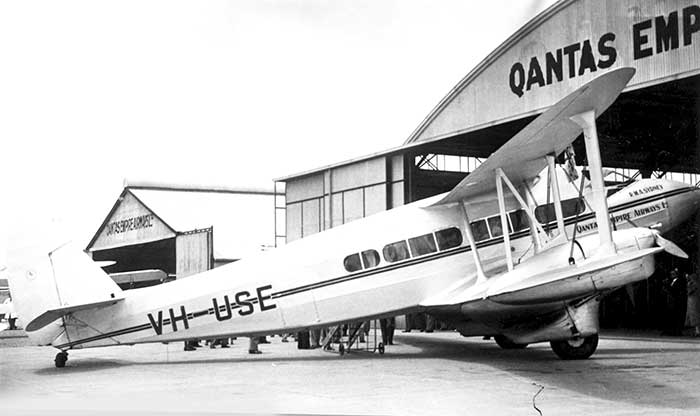
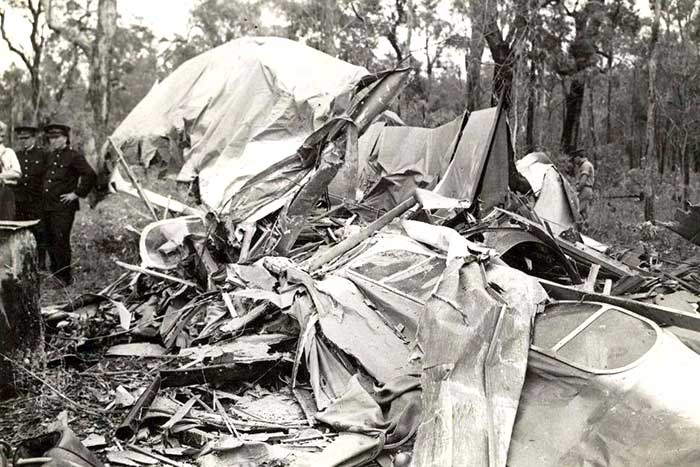
Photo: Queensland Police via Martin Edwards
| 12.34 |
Built at Hatfield by De Havilland Aircraft Co Ltd. Production DH.86 |
| Australian Civil Aviation Branch allocated registrations VH-USC to -USG to the Qantas DH.86s. Australian registration was painted on the airframe at the DH factory |
|
| 27.12.34 |
British CofA issued VH-USF: Qantas Empire Airways Ltd, Brisbane Qld |
| VH-USF was used for performance trials at Hatfield with various “engine-out” combinations, and trials of structural modifications carried out at Hatfield and later at Martlesham Heath. Modifications included strengthening of fin post, removal of rudder servo tab | |
| 7.1.35 |
Trials completed |
| Because
CAB had grounded DH.86s in Australia, QEA and Imperial Airways agreed
that VH-USF would be flown to Singapore by Imperial Airways and
operated by them between Singapore-Darwin along with Imperial Airways A.W.15 Atalantas until the grounding order was
lifted and Qantas was able to commence flying the sector with their own
DH.86s |
|
| 7.1.35 |
VH-USF departed Croydon Aerodrome, London on the ferry flight to Australia under command of Imperial Airways Captain James Youell, holder of a British Master Pilot 's Licence. Among its requirements was 2,000 hours of night flying. |
| 20.1.35 |
Arrived at Singapore. Continued to Darwin two days later |
| 22.1.35 |
Inspection report at Singapore en route to Australia. QEA had despatched two engineers to Singapore to make a detailed inspection of the structural integrity of the tailplane, particularly the fin post. Airframe time 60 hrs |
| 22.1.35 |
Officially added to Civil Register as VH-USF Qantas Empire Airways Ltd, Brisbane Qld |
| 22.1.35 |
VH-USF departed Singapore for Darwin, still under command of IAL Captain Louell. Routed Batavia-Surabaya-Rambung that day, to Kupang (Timor) and Darwin next day. |
| 23.1.35 |
On
arrival Darwin NT, the tailplane was inspected by CAB aircraft
inspector E. B. Bunting and IAL Captain Youell. The fin post had come loose
and a design problem with the fin bias gear was identified. CAB approval for Youell to fly VH-USF from Darwin back to Singapore the following day for repair by Imperial Airways engineers based Singapore. On arrival Singapore, the British CofA was temporarily suspended. |
| 25.2.35 |
VH-USF
departed Singapore on the inaugural eastbound Qantas DH.86 service to
Australia, taking over the Singapore-Darwin sector temporarily flown by
Imperial Airways while Australian DH.86s were grounded. VH-USF reached Brisbane three days later, QEA Captains H. B. Hussy and L. J. Brain. The early services carried airmail, no passengers |
| 14.3.35 |
Australian CofA issued. Official issue was delayed due investigations into DH.86 accidents |
| 17.4.35 |
First passengers were carried when Lady Mountbatten and two other passengers boarded VH-USF at Charleville Qld, bound for Singapore |
| 35-38 |
Flown on the Brisbane-Singapore-Brisbane route until the Short Empire flying boats took over, when the remaining QEA DH.86s operated outback Queensland services until sold |
| 24.5.40 |
Annual CofA renewal completed at Archerfield, test flown the same day by Captain E.W. Donaldson. Airframe time 6092 hrs |
| 25.7.40 |
DCA Inspection report at Archerfield on condition for Impressment: condition good, fitted flaps: currently dismantled for overhaul. Total airframe time 6211 hrs |
| 28.9.40 |
Impressment Requisition No.8177 served on QEA by Australian Government
for issue to RAAF. To be delivered to Essendon by QEA and handed over to CO 3EFTS Essendon |
| 6.10.40 |
Taken on RAAF charge as "DH.86A" A31-6. Received ex QEA at 3EFTS Essendon. Delivered Brisbane-Essendon by QEA Captains Donaldson & McMaster |
| 6.10.40 |
To be issued to Ansett Airways for inspection and installation of modifications for RAAF service. However the civil contractor was changed to ANA Essendon |
| 7.1.41 |
Allotted to 1Air Observers School, Cootamundra NSW. Expected to be ready at ANA by 11.1.41 |
| 15.1.41 |
A31-6 inspection report at Essendon. Airframe time 6480 hrs |
| 16.1.41 |
Departure Essendon on delivery delayed due weather |
| 20.1.41 |
Serviceable at 1AOS |
| 7.2.41 |
Allotted to No.1 Air Ambulance Unit. Allotment cancelled, remained at 1AOS |
| 24.4.41 |
A31-6 arrived at ANA workshops Essendon from Cootamundra for maintenance, departed next day. |
| 3.42 |
Due lack of RAAF transport capability, DCA negotiated an agreement for RAAF to loan the former VH-USC, USF & USW to Qantas Empire Airways to operate military charter flights to Darwin areas and New Guinea, flown by civil QEA pilots |
| 1.4.42 |
CofA renewed by QEA at Archerfield. Painted in camouflage |
| 8.4.42 |
Restored to Civil Register VH-USF Department of
Civil Aviation, for use by Qantas Empire Airways |
| The initial task by QEA was to evacuate civilians trapped by Japanese advances at Mount Hagen
in the New Guinea highlands. VH-USC & USF had
long-range fuel tanks and altitude controls fitted for flights over the
12,000 feet mountains to reach Mount Hagen. VH-USW could not be used and was returned to RAAF |
|
| 13.5.42 |
VH-USC & USF took off from Horn Island at 7am to commence the
evacuation of civilians and soldiers stranded at Mount Hagen. Both
aircraft operated from Horn Island on the tip of Cape York Qld, flying
across New Guinea through difficult tropical weather and under threat
from Japanese aircraft. The operation was completed on 24.5.42 when 86
civilians and soldiers had been flown to safety from Mount Hagen. The two DH.86s were operated by QEA volunteers Captains Orm Denny, Eric Sims, Rex Nicholl, with radio operators F. S. Furniss, R. J. Anderson, L. W. Louttit and ground engineers D. E. Chambers and R. G. Carswell |
| 6.42 |
VH-USC & USF were now operated by QEA on military charters as directed by military aurthorities, mostly to Darwin NT and Batchelor NT |
| 28.7.42 |
Damaged at Batchelor NT when Captain R. B. Tapp was taxying at night. The DH.86's wing
struck a parked Curtiss P-40. Accident report states that the DH.86 was painted in camouflage |
| 10.8.42 |
Forced landing Camooweal Aerodrome Qld, due engine trouble. Captain D. F. McMaster |
| 1.43 |
After military charters in New Guinea, VH-USC & USF were based Archerfield and used by QEA on military charters to Darwin area and also on their western Queensland civilian routes |
| 13.12.42 |
VH-USC & USF began a series of supply dropping flights
from Port Moresby to Australian Army troops at the Buna ground battle area on the northern coast of New Guinea |
| 22.3.43 |
Aborted takeoff Archerfield due fuel flow problem on a charter flight to Batchelor NT. No damage. Captain Tennant |
| 21.9.43 |
Crashed on takeoff at Roma Qld, badly damaged. Violent ground-loop caused the starboard undercarriage to collapse. QEA Captain F. I. Flynn was unhurt. |
| 22.9.43 |
Captain Orm Denny arrived Roma in a QEA DH.90 Dragonfly, bringing two QEA engineers R. G. Carswell and I. Hewitt to carry out temporary repairs at Roma |
| 1.10.43 |
VH-USF’s rudder and bracing wires were removed and fitted
overnight to VH-USC whose tailplane was damaged when struck by an eagle on arrival at Roma that day |
| 30.10.43 |
VH-USF ferried Roma-Archerfield for complete overhaul and repair by QEA |
| 9.7.44 |
Damaged in ground-loop on takeoff at Blackall Qld. Port outer engine failed on takeoff roll, causing a violent swing. Starboard wing, undercarriage and propellers damaged. QEA Captain W. Forgan-Smith was unhurt. Accident report quotes: “On loan to DCA from Dept of Air, operated by QEA” |
| 2.8.44 |
Letter to RAAF HQ from DCA: damaged aircraft to be returned to RAAF less parts needed to make other aircraft serviceable |
| 10.8.44 |
RAAF Status Card: A31-6 allotted to No.3 Central Recovery Depot, Amberley for survey report on airframe and engines |
| 16.8.44 |
RAAF HQ letter: 3CRD will salvage all components and deliver them to RAAF Amberley Qld |
| Dismantled damaged airframe stored in the open at Amberley, the four engines stored under cover |
|
| 13.12.44 |
Conference between DCA, Department of Air, RAAF and
Commonwealth Disposals Commission discussing disposal of military aircraft, recorded:
“In relation to the one whole and one crashed DH-86 available, one firm offer has been made but it is the opinion of the conference that as these machines will be of interest to a number of airline operators, quick tenders be invited from all operating companies throughout the Commonwealth.” |
| Offered for disposal in damaged condition by Commonwealth Disposals Commission |
|
| 1.45 |
Sold by CDC to MacRobertson Miller Aviation Co, Perth WA Included in the same sale was DH.86 A31-4 (ex VH-USW) also held at Amberley |
| 2.2.45 |
RAAF Status Card: Held at 3CRD in crashed condition for disposal. Successful tenderer is MacRobertson Miller Aviation Co. Captain J. Woods and company representative will be visiting Amberley and may be permitted to inspect aircraft. Not to be issued until instructed |
| 13.2.45 |
RAAF Status Card: Authority granted for issue aircraft to MacRobertson Miller Aviation Co ex 3CRD |
| 2.45 |
MMA Chief Engineer Frank Colquhoun selected Charlie Rolandi
from his Perth maintenance staff to accompany him to RAAF Amberley to
prepare the two DH.86s for ferry to Perth. He later wrote:
“VH-USW was in serviceable condition except for a pre-flight
inspection. VH-USF however had suffered a ground-loop at Blackall and
had been disassembled and transported to 3AD at Amberley where all
components were unloaded and stored in an open compound. We were soon
able to give USW a pre-flight and send word to Perth to send Captain
Jim Woods over to ferry the aircraft back to Maylands. This was all
done without incident and our full attention was then devoted to the
repair of VH-USF.”
|
| 12.3.45 |
RAAF Status Card: A31-6 issued to MMA ex 3CRD. Struck-off RAAF charge. |
| 22.3.45 |
Letter to DCA from MMA, Perth: “VH-USF & VH-USW have been purchased by us from RAAF through the Commonwealth Disposals Commission” |
| 3.45 |
DCA wrote to MMA setting out the current airframe modifications
and inspections required for the DH.86 and outlined the type’s history of
fatal accidents. The Department warned of reports of aileron reversal at high
airspeeds and structural failure of the fin. Internal DCA memos indicate considerable concern over the unexpected development of DH.86s continuing in airline service after the war, but no outstanding airworthiness issue allowed the Department to ban the type. There was an acceptance that because of MMA’s pre-war experience with DH.86s, the company would be a satisfactory operator of the type |
| 3.45 |
MMA sent Captain James Woods to ferry the aircraft to Perth. Chief Engineer Colquhoun later wrote: “Many small items from the interplane rigging were missing. They had to be substituted with high tensile bolts and other makeshift alternatives. The exercise was to make the aircraft flyable for a ferry to Perth for complete overhaul. Large sections of belly fabric were missing and had to be replaced and given the full normal doping process. The wheel brakes were poor and re-adjusted but not with a very confident result.” |
| 3.45 |
Test flight at RAAF Amberley by MMA Captain James Woods |
| 3.45 |
The Commonwealth Disposals Commission sale of this aircraft
included some spares, primarily tyres and inner tubes, located at No.3
Stores Depot at Kingaroy Qld. Woods flew from Amberley to Kingaroy with the two repair staff on board, to collect the spares. Some items on the listed inventory were missing, but they returned to Amberley that afternoon with the majority of items |
| 9.3.45 |
VH-USF ferried from Amberley to Archerfield Airport, Brisbane
by Woods, carrying the two repair staff. Chief Engineer Frank Colhoun
later wrote: “It was considered a strategic move to arrive at
Archerfield on a Saturday morning when there were no DCA inspectors on
duty. Though I was quite happy with our makeshift temporary repairs
with substitute items, I had strong doubts about DCA inspecting and
approving the aircraft, even just for the ferry flight to Perth.” A tyre blew out on landing Archerfield, and the crew were grateful for willing assistance given by the duty ANA foreman Bill Gastrell, who provided jacks to raise the aircraft to allow the blown tyre to be replaced. He also offered to regrind the brake drums and refit the brake shoes, which improved their effectiveness |
| 30.3.45 |
Departed Archerfield at 7.10am for Sydney. Captain Woods had
agreed to take along 3 RAAF personnel who were commencing leave and
were eager to get to Sydney. Because there were no passenger seats,
they sat on the cargo of tyres in the cabin. Landing at Mascot in gusty winds and rain, Woods lost control and the aircraft ground-looped, stopping on the runway with port undercarriage collapsed. To vacate the runway, the starboard side was jacked up and a Qantas freight trolley moved under the collapsed landing gear |
| 31.3.45 |
The damaged aircraft was moved into a Qantas hangar, where Coulhoun and Rolandi started the repairs again. Qantas had no DH.86 parts in store, but some essential items were obtained from ANA at Essendon. Repairs took 20 days |
| 4.45 |
Captain Woods returned from Perth to Sydney to continue the ferry flight
to Perth. Took 3 days with refuelling stops at Essendon, Parafield, Ceduna, Forrest and Kalgoorlie |
| 24.4.45 |
DCA Memo from Perth office
to Head Office: VH-USF is at Maylands Aerodrome, Perth. MMA have
commenced a complete overhaul, expected to take 4 weeks |
| 22.5.45 |
Restored to Civil Register as VH-USF: MacRobertson Miller Aviation Co Ltd, Perth WA |
| 22.6.45 |
Test flown after the overhaul at Maylands, pilots James Woods and Horrie Miller |
| 23.6.45 |
CofA renewed at Maylands WA |
| 24.6.45 |
Crashed on takeoff Geraldton WA. This was its inaugural MMA service, from Perth to Geraldton and Carnarvon, Captain H.J. "Jim" Branch (over 10,000 hours experience, 900hours on MMA DH.86s prewar) and First Officer Don W. Rumney. After refuelling at Geraldton, the takeoff appeared normal but the aircraft did not climb and turned back for a landing. It flew low over RAAF hangars at about 300 feet then made a steep turn to port, followed by a wide low circuit back to the runway with port wing low. When just inside the aerodrome boundary, it dropped heavily on the starboard main undercarriage, bounced, contacted the ground with the tailwheel and bounced again. Striking the ground for the third time, this time on the port main wheel, as it bounced higher, engine power was applied but the aircraft swung to the left, banking steeply until the left wings were torn off by ground contact. The aircraft cartwheeled and hit the ground nose-first. The fuselage broke up, spilling out most of the 11 occupants. Captain Branch and one passenger were killed, the other 9 occupants seriously injured |
| The DCA accident investigation report placed the blame squarely on Captain Branch: “The accident was caused by an indifferent landing which had worsened until the aircraft became completely out of control.” |
|
| However the investigation panel was criticised for not including, or
failing to take evidence from, any DCA officer involved in previous
Australian DH.86 accidents. Their report acknowledged that the type was
prone to swung during takeoff or landing and that such swings were
usually difficult to control, and listed 9 accidents to Australian
DH.86s involving such swings. But the report did not address the extreme port wing drop soon after airborne or the reason for returning, or the very wide circuit so close to the ground. It seemed that events prior to touchdown were deemed irrelevant. |
|
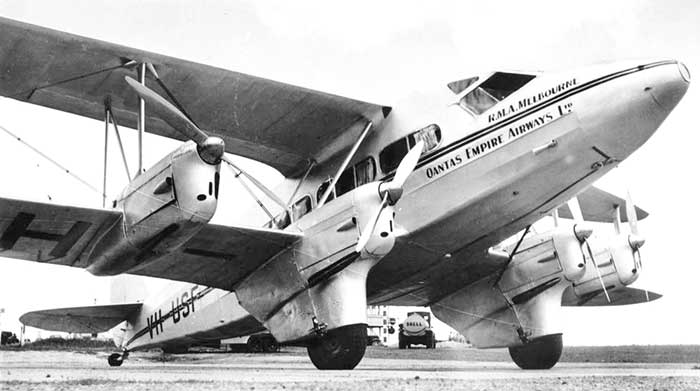
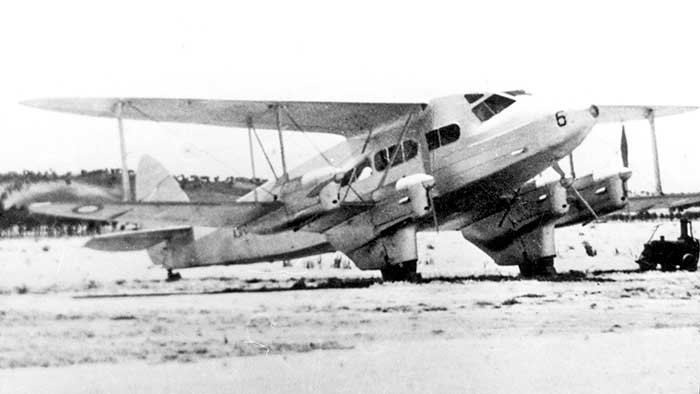
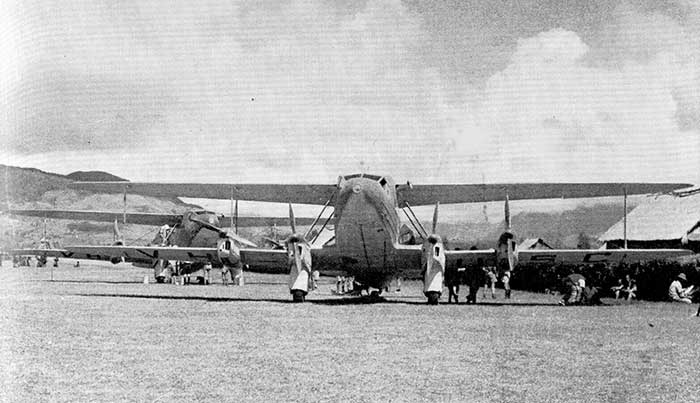
May 1942, during the 11 day shuttle to evacuate stranded civilians and soldiers ahead of the Japanese advance.
Both were painted in camouflage and operated by Qantas volunteer pilots and engineers. Photo: Qantas
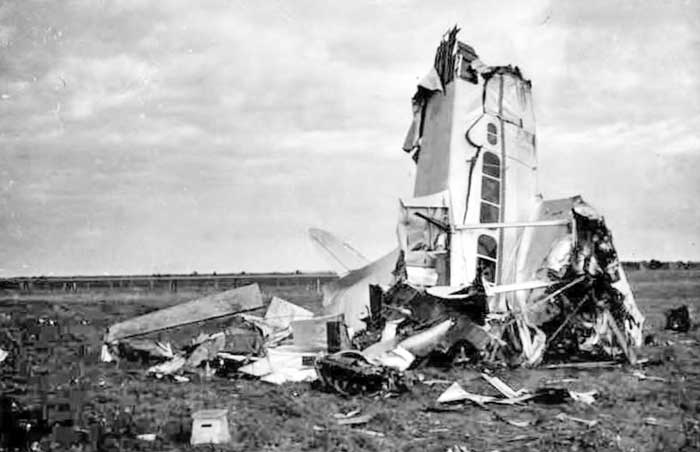
unable to control the
aircraft immediately after
takeoff.
Photos: DCA via Greg Thom
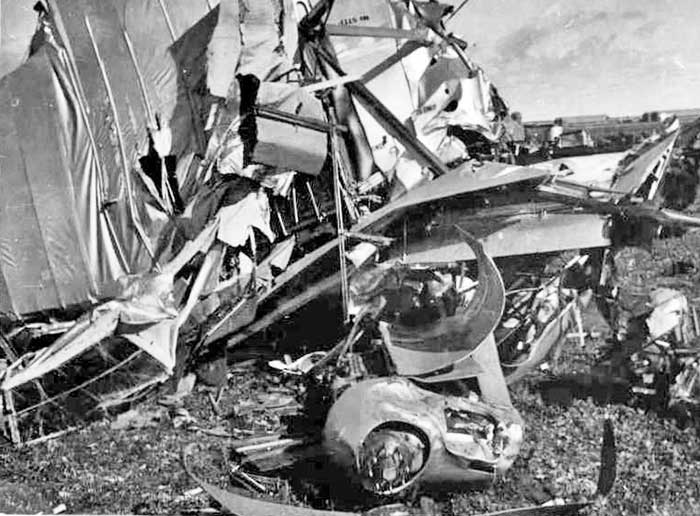
| 10.34 |
Built at Hatfield by De Havilland Aircraft Co Ltd. Production DH.86 |
| Australian Civil Aviation Branch had allocated registrations VH-USC to -USG to the Qantas DH.86s. Australian registration was painted on the airframe at the DH factory |
|
| 18.10.34 |
British CofA issued VH-USG: Qantas Empire Airways Ltd, Brisbane Qld |
| Due
to delivery delays, it was decided to deliver VH-USG by air rather than
by sea as originally intended. Imperial Airways agreed to release a
crew for the ferry flight to Brisbane: Captain D. R. Prendergast, copilot /radio operator W.V. Creates, engineer F. R.Charlton. (Captain Prendergast had previously flown Imperial Airways Armstrong Whitworth Atalanta G-ABTL Astraea to Australia on a proving flight for the Britain-Australia air mail in June 1933) |
|
| 13.11.34 |
Arrived Darwin on delivery flight from England. Continued to Brisbane. The aircraft was carrying a spare Gipsy Six engine and a consignment of spare parts |
| 15.11.34 |
Crashed destroyed, Barsdale Station, Ilfracombe, near Longreach Qld. VH-USG had just departed Longreach on the final stages of the delivery flight from England to Brisbane. Kangaroo shooters saw it make a flat right turn which developed into a flat spin. The three crew plus one passenger, Shell Company representative E. Broadfoot, were killed The investigation found that the flight engineer was in the Captain's seat and the Captain was in the rear lavatory. The cause of the loss of control was stated to be sideways displacement of the tail fin due to failure of the fin-trim mechanism in flight. The bias screw had been constructed out of correct position |
| 11.34 |
Urgent
inspections of the tail fin-trim mechanism of all other Qantas DH.86s
revealed wide variations between individual aircraft. - VH-USD was checked when it was uncrated at Archerfield, revealing a cracked fin post and the bias screw constructed out of position similar to the crashed VH-USG - VH-USE bias screw also out of position but a lesser displacement - VH-USF inspected at Singapore during its delivery flight: bias screw was out of position in a different displacement to the others. QEA Managing Director Hudson Fysh wrote "The box-fitting incorporated as a modification by DH was all that saved a fracture of the bottom end of the fin post and a repetition of the Longreach accident." |
| Collection of airframe parts displayed at Qantas Founders Museum, Longreach Qld |
|
| Crashed prior to formal registration as VH-USG |
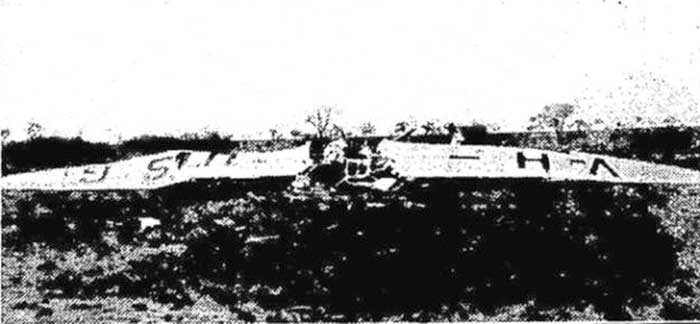
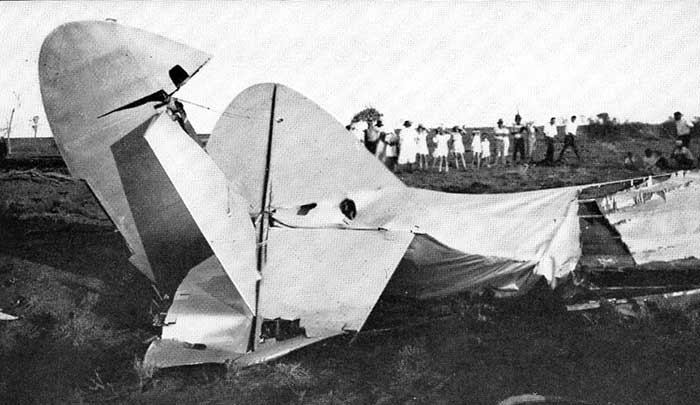
| 1.35 |
Built at Hatfield by De Havilland Aircraft Co Ltd. Production DH.86 |
| Registration allocated G-ACWE: Imperial Airways Ltd, Croydon Airport, London | |
| This aircraft from the Imperial Airways order was transferred to Qantas to replace VH-USG which had crashed 15.11.34 on its delivery flight from England to Brisbane | |
| 31.12.34 |
CAB wrote to Qantas Empire Airways, Brisbane advising that registration VH-UUA had been reserved for the DH.86 acquired to replace VH-USG |
| 22.1.35 |
Added to Civil Register VH-UUA: Qantas Empire Airways Ltd, Brisbane Qld |
| 14.2.35 |
British CofA issued to VH-UUA |
| 3.35 |
Delivered from England to Australia by air, flown by an Imperial Airways crew |
| 28.3.35 |
VH-UUA arrived at Archerfield Aerodrome, Brisbane at end of the ferry flight. It had carried airmail Singapore-Brisbane |
| 2.4.35 |
CAB memo: engineers from De Havilland Aircraft Pty Ltd are at Archerfield fitting flaps to VH-UUA |
| 3.4.35 |
Inspection report at Archerfield after flaps installed. Test flown same day by Captain H. B. Hussey. Airframe time 105 hrs. |
| 8.4.35 |
Australian CofA issued at Archerfield |
| 27.6.36 |
Rear fuselage damaged when starboard tyre burst on landing at Roma Qld.
Wheel dug into the dirt surface causing aircraft to swing around
violently with the tail-skid lifted off the ground. Captain H. B. Hussey and one passenger, no injuries |
| 18.7.36 |
Test flown at Roma after repairs, Captain L. J. Brain. Airframe time 1094 hrs |
| 15.6.37 |
Annual CofA renewal completed Archerfield, test flown that day by Captain G. U. Allen. Airframe time 2434 hrs |
| 18.8.37 |
Swung on landing at Winton Qld in a crosswind, causing the starboard undercarriage to collapse. Captain R.S.Adair, 7 passengers, no injuries. Scheduled Singapore-Brisbane airmail service |
| 26.8.37 |
Test flown at Winton after repairs completed |
| 4.7.38 |
Annual CofA renewal completed Archerfield, test flown that day by Captain R. B. Tapp. Airframe time 3943 hrs |
| 8.9.38 |
Sold to Tata & Sons /Tata Group Ltd, Bombay, India |
| 9.38 |
Registered VT-AKM: Tata Group Ltd, Bombay. Operated by Tata Airlines |
| 10.9.38 |
Letter from QEA to CAB advises that VH-UUA has now left the country, sold to Tat & Sons, Bombay |
| 12.9.38 |
Struck-off Australian Register |
| .41 |
Impressed in India for RAF, allocated serial HX789 |
| 13.1.42 |
Struck-off Indian Civil register as impressed |
| 42 |
In use with No.5 Flight, Indian Air Force Volunteer Reserve |
| 15.9.42 |
Swung on takeoff at Cochin, India. Undercarriage collapsed. |
| 2.7.43 |
Struck off RAF charge as Category E damage |
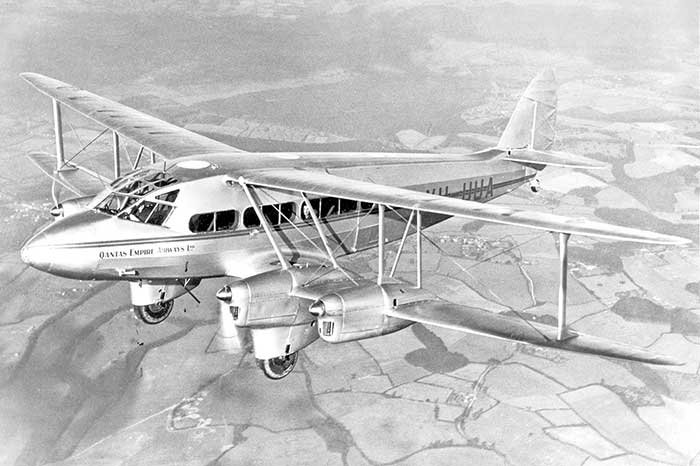
This de Havilland photograph of VH-UUA was taken in England in early 1935, prior to delivery to Australia.
Dave Freeman collection courtesy SA Aviation Museum
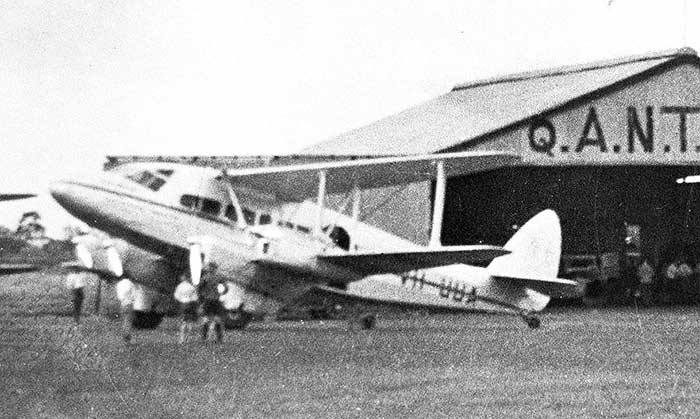
VH-UUA at Longreach, Queensland with the iconic Q.A.N.T.A.S. hangar behind. Neil Follett collection
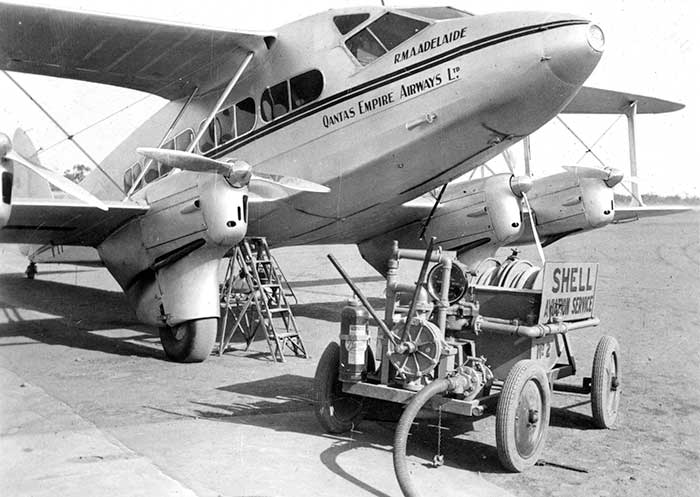
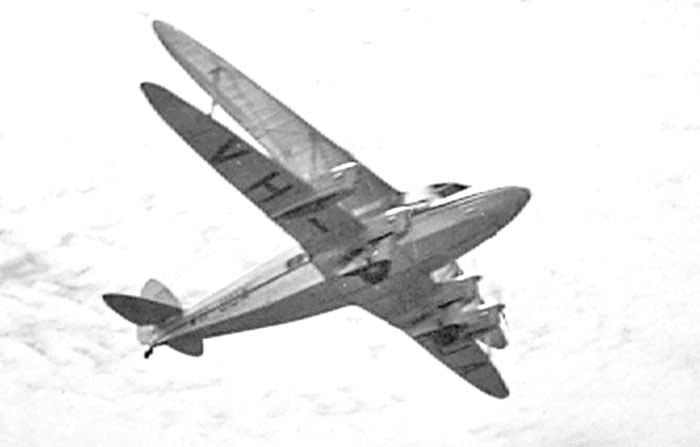
Lester J. Brain collection courtesy Dave Eyre
| .34 |
Built at Hatfield by De Havilland Aircraft Co Ltd. Production DH.86 |
| Ordered by Tasmanian Aerial Services Pty Ltd, Launceston Tasmania | |
| 9.34 |
Company reformed as Holyman’s Airways Pty Ltd, Launceston, Tas |
| Shipped to Australia |
|
| 3.1.35 |
Expected arrival at Port Melbourne Vic |
| Assembled at RAAF Laverton Vic | |
| 23.1.35 |
First test flight at RAAF Laverton after assembly |
| 29.1.35 |
Added to Register VH-URT: Holyman’s Airways Pty Ltd, Launceston Tas. Named Loina |
| 29.1.35 |
CofA issued |
| 4.2.35 |
First airline service Essendon-Launceston. |
| 2.10.35 |
Crashed in sea off Flinders Island. Operating a scheduled airline service from Melbourne to Launceston, with a stop at Flinders Island, midway across Bass Strait. Last radio message said approaching Flinders island at 1,000 feet. Floating wreckage was later found near the island. Two witnesses stated they saw the aircraft bank sharply to port then dive into the sea Captain Norman Evans, First Officer Max Brown, Engineer Edward Best and two passengers lost. |
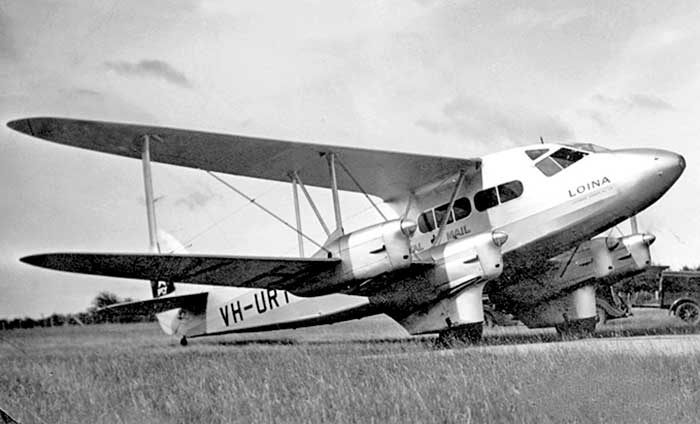
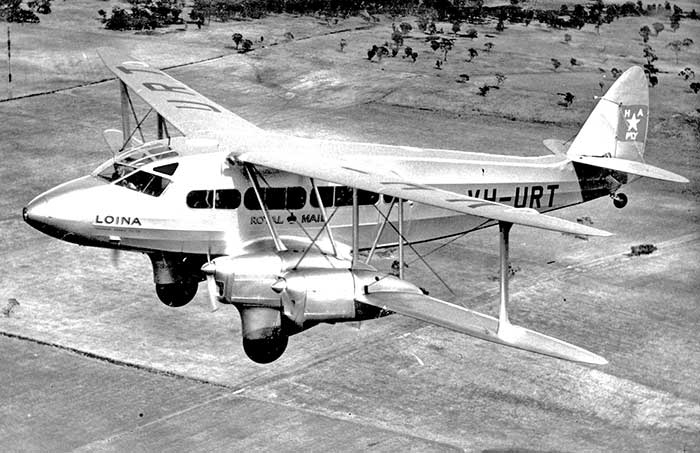
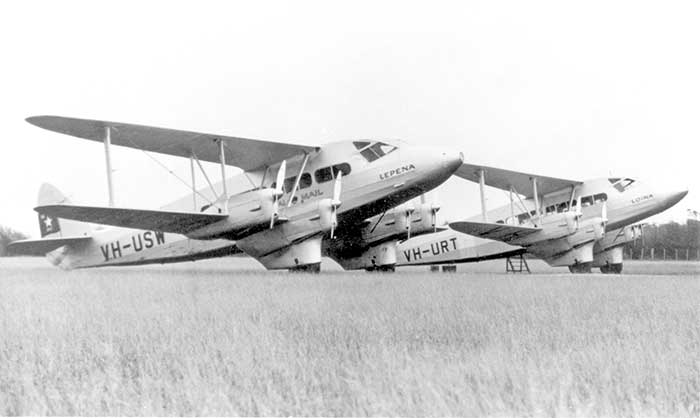
| 2.35 |
Built at Hatfield by De Havilland Aircraft Co Ltd. Production DH.86 |
| Ordered by Holyman's Airways to replace VH-URN lost at sea in Bass Strait 19.10.34 | |
| Australian CAB allocated registration VH-USW to DH.86 c/n 2315 for Holyman's Airways 5.11.34 |
|
| 4.3.35 |
First flight Hatfield |
| 6.3.35 |
British CofA issued as VH-USW: Tasmanian Aerial Services Pty Ltd, Launceston Tas (Despite this company having been reformed as Holyman’s Airways Pty Ltd in October 1934) |
| 3.35 |
Shipped to Australia |
| 5.35 |
Assembled at RAAF Laverton Vic, supervised by De Havilland Aircraft Pty Ltd, Sydney |
| 7.5.35 |
Letter to the Controller of Civil Aviation from Ivan N. Holyman, Managing Director of Holyman’s Airways Pty Ltd, advising that VH-USW is currently under assembly at Laverton |
| 10.5.35 |
First test flight Laverton after assembly, pilot Major Alan Murray Jones of DHA. Airframe time 2 hrs 40 mins |
| 13.5.35 |
Added to Civil Register VH-USW: Holyman’s Airways Pty Ltd, Launceston Tas. Named Lepena |
| 13.5.35 |
Initial 6 month Australian CofA issued. Seating for 12 passengers |
| Operated airline services from Tasmania across Bass Strait to Melbourne |
|
| 2.10.35 |
Flown by Holymans Captain Ken Frewin on sea search for themissing Holymans Airways DH.86 VH-URT Loina |
| 10.35 |
Extensive test flying by
Captain Ken Frewin in an attempt to identify loss of control situations
that may have been the cause of URT's loss. Crew wore parachutes |
| 30.10.35 |
CofA renewal completed at Launceston, test flown that day by Captain K. M. Frewin. Airframe time 370 hrs |
| 13.12.35 |
Crashed during forced landing on Hunter Island in Bass Strait. While on a scheduled flight from Launceston to Melbourne, Captain Alex M. Bayne and First Officer Des H. Ditchburn were concerned by movement of the lower fairing on the port inter-plane strut which had vibrated loose, giving the appearance that the strut itself was breaking away from the wings. Morse code radio message from aircraft: "The wing struts have collapsed. Trying to put down on Hunter Island" Fearing the aircraft would break up in flight, an emergency landing was made on a grass plateau on Hunter Island. Damage to undercarriage and lower wings, engines. No injuries to 2 crew and 6 passengers, who were taken off the island the next day by the ketch Phyllis |
| 2.36 |
Damaged aircraft was salvaged by a team from Mathews Aviation at Essendon Airport, Melbourne. The crash site was in the centre of the island, 10 Km from the shore. Salvage crews walked overland from boats, carrying their own supplies and food. The DH.86 was dismantled, engines and airframe sections moved to shore along a track cleared through low scrub. The fuselage on its wheels was pulled by ropes. All components were lowered down a cliff to the shore, where they were loaded on a raft for transfer to the waiting ketch Valetta May. |
| 20.2.36 |
Wreck arrived at Port Melbourne on board the ketch Valetta May. Moved to Essendon for repair |
| The Insurance company called for tenders to rebuild VH-USW. Awarded the job to Holyman’s Airways | |
| 12.5.36 |
Struck-off Register, during rebuild at Essendon |
| 1.10.36 |
Restored to Register VH-USW: Holyman’s Airways Pty Ltd, Launceston Tas |
| 1.10.36 |
Test flown Essendon after rebuild, Captain C. H. Scott. Airframe time 538 hrs |
| 6.10.36 |
Minor damage landing Mascot. Rolled off end of runway to a sandy ditch and the starboard undercarriage and wing settled gently in the ditch. Captain R. Watt and 6 passengers unhurt |
| 14.10.36 |
Damaged when tyre burst on takeoff at Essendon. Starboard wings, engines and undercarriage damaged. Captain F. W. Collopy and 3 passengers unhurt. |
| 22.10.36 |
Test flown Essendon after repair, Captain A. M. Bayne |
| 1.11.36 |
Change of ownership due merger: Australian National Airways Pty Ltd, Melbourne Vic Retained the same name Lepena |
| 2.11.36 |
First ANA passenger service |
| 14.12.36 |
VH-USW operated ANA’s inaugural Sydney-Canberra-Wagga-Melbourne route. Captains Croucher and Presgrave. Wagga was a new port for the airline |
| 37-40 |
Operated ANA airline services on southern routes, various minor incidents and diversions recorded at Essendon, Mascot, Wagga etc |
| 29.12.37 |
Badly damaged in ground-loop on takeoff at Wagga NSW, port undercarriage collapsed. No injuries. Captain Don T. Saville |
| 6.1.38 |
Test flight at Wagga, after rebuild. Captain L. M. Diprose
with the 3 ANA engineers who had repaired the aircraft on board. The
DH.86 swung again during the takeoff roll, ground-looped and the port
undercarriage collapsed again |
| CAB review of the Wagga accidents noted that VH-UUB was fitted with flaps, but VH-USW was not | |
| 28.3.38 |
Test flown Essendon, after complete rebuild due to the Wagga accidents.
Captain L. McK Johnson. Airframe time 2272 hrs |
| 13.4.39 |
Annual CofA renewal completed at Essendon. Test flown same day. Airframe time 4244 hrs |
| 29.6.39 |
Skidded on wet surface landing at Wynyard Tas, damaging
undercarriage and all four propellers. Captain E. B. Annear, 6 passengers unhurt |
| 11.39 |
DCA Inspection report at Essendon to assess condition and availability for impressment. Condition assessed as good, engines have good hours to run, airframe time 5,125 hours |
| 17.1.40 |
Forced landing Archerfield Qld due engine trouble, no damage. Captain Young, 8 passengers |
| 6.7.40 |
Impressment Requisition No.8170 served on ANA by Australian Government for VH-UUB, and No.8170 for VH-USW. Both to be delivered by ANA to Essendon on 13.9.40 where they are to be handed over to the Commanding Officer of No.3 EFTS |
| 25.7.40 |
DCA memo mentions VH-USW is at Archerfield |
| 8.9.40 |
VH-USW flew the Airlines of Australia service Cairns-Townsville-Mackay-Rockhampton-Brisbane. Delayed at Mackay Qld due broken cowling locking pin. Captain E. B. Annear |
| 13.9.40 |
Taken on RAAF charge as "DH.86A" A31-4. Received 3EFTS Essendon ex ANA |
| 13.9.40 |
Issued to Ansett Airways, Essendon for overhaul and installation of RAAF mods prior to entering RAAF service. |
| 9.40 |
Damaged by a gale at Essendon. Repaired by Ansett Airways while carrying out the RAAF mods |
| 1.11.40 |
A31-4 Inspection Report at Essendon after pre-delivery overhaul and mods for RAAF. Airframe time 7227 hrs |
| 29.11.40 |
Allotted No.1 Air Observers School, Cootamundra when overhaul completed |
| 19.12.40 |
Received 1AD Laverton ex 3EFTS Essendon, prior to delivery to 1AOS |
| 27.12.40 |
Torn from moorings by strong winds while parked unoccupied at Laverton. Blown on to starboard wings, both badly damaged. |
| 2.4.41 |
Issued to 1AOS, Cootamundra ex 1AD after repair at Laverton. All silver finish |
| 3.42 |
Due lack of RAAF transport capability, DCA negotiated an agreement for RAAF to loan the former VH-USC, USF & USW to Qantas Empire Airways to operate military charter flights to Darwin areas and New Guinea flown by civil QEA pilots |
| 26.3.42 |
Restored to Register VH-USW: Department of Civil Aviation for use by Qantas Empire Airways |
| 26.3.42 |
CofA renewed |
| 26.3.42 |
RAAF Status Card A31-4: issued to Qantas ex 1AOS Cootamundra |
| 8.4.42 |
DCA Memo: VH-USW could not be used by QEA and it was agreed
with DCA that it would be returned to RAAF. (Compiler’s note: reason not given. it is assumed that because of the loss of staff and facilities experienced by Australian airlines due to the war, QEA did not have the maintenance ability or pilots to effectively utilise a third DH.86 at this time) |
| 4.5.42 |
DCA Archerfield memo to DCA Head Office: VH-USW is parked outside at Archerfield waiting for a RAAF crew to ferry it back to RAAF Cootamundra |
| 4.5.42 |
Returned to RAAF as A31-4. Received 1AOS Cootamundra ex Qantas |
| 5.5.42 |
Issued to ANA Essendon ex Cootamundra for conversion to air ambulance |
| 29.5.42 |
Conversion to air ambulance completed by ANA, awaiting collection at Essendon |
| 31.5.42 |
Received 1AD Laverton ex ANA |
| 16.6.42 |
Issued to No.2 Air Ambulance Unit, Kingaroy Qld ex 1AD. |
| 14.11.42 |
A31-4 was at Alice Springs northbound, pilot Flt Lt Loxton |
| 17.3.43 |
Received at De Havilland Aircraft, Mascot ex 2AAU for overhaul |
| 8.8.43 |
Received 2AAU ex DH Aircraft via 2AP Bankstown |
| 4.9.44 |
Cable from DCA HQ to DCA Archerfield office: "RAAF will deliver to you DH.86 A31-4 ex VH-USW on 7.9.44. Hand aircraft over to QEA for Brisbane-Darwin service. QEA to remove and store ambulance fittings and install passenger seats ex VH-USF held at RAAF Recovery Depot Amberley.” |
| 6.9.44 |
A31-4 Status Card: allotted to Department of Civil Aviation ex 2AAU. Free issue.
Ambulance fittings to be removed. Aircraft to be issued to DCA representative at Archerfield |
| 7.9.44 |
Flown to Archerfield by RAAF crew on this date, for handover to DCA for issue to a civil airline |
| 8.9.44 |
DCA Inspection report Archerfield: airframe is in poor condition, all 4 engines require overhaul |
| 21.9.44 |
Memo from DCA Archerfield office to DCA Head Office: “R. S. Adair of Aircrafts Pty Ltd definitely not interested in this aircraft but would like a DH.86 with flaps and in much better condition. This aircraft is in poor condition and requires a complete overhaul.” |
| 15.11.44 |
DCA memo: this aircraft intended to be handed over to
Qantas Empire Airways for their Brisbane-Darwin service, but the
airframe is in poor condition and all four engines need overhaul.
Aircrafts Pty Ltd, Archerfield were
interested in acquiring the aircraft but decided against it, due its
poor condition. Aircrafts Pty Ltd have offered £1000 “as is” but will require £2000 to
recondition. It will instead be made available for disposal by
Commonwealth Disposals Commission. |
| 13.12.44 |
Conference between DCA, Department of Air, RAAF and
Commonwealth Disposals Commission discussing disposal of military aircraft, recorded:
“In relation to the one whole and one crashed DH-86 available, one firm offer has been made but it is the opinion of the conference that as these machines will be of interest to a number of airline operators, quick tenders be invited from all operating companies throughout the Commonwealth.” |
| 4.1.45 |
A31-4 RAAF Survey Report at 3AD Amberley Qld: airframe in rough condition with areas of minor damage. Complete overhaul will be required. Airframe time 8708 hrs |
| 1.45 |
Sold by Commonwealth Disposals Commission to MacRobertson Miller Aviation Co Ltd, Perth WA Included in the same sale was badly damaged DH.86 A31-6 (ex VH-USF) also held at Amberley |
| 2.2.45 |
RAAF Status card: Aircraft held at 3AD in for disposal by Commonwealth Disposals Commission in “as is” condition. Successful tenderer MacRobertson Miller Aviation Co. Captain J. Woods and a representative of the company will be visiting Amberley and may be permitted to inspect aircraft. Not to be issued until instructed. |
| 2.45 |
MMA Chief Engineer Frank Colquhoun selected Charlie Rolandi
from his Perth maintenance staff to accompany him to RAAF Amberley to
prepare the two DH.86s for ferry to Perth. He later wrote: “VH-USW was in serviceable condition except for a pre-flight inspection. VH-USF however had suffered a ground-loop at Blackall and had been disassembled and transported to 3AD at Amberley where all components were unloaded and stored in an open compound. We were soon able to give USW a pre-flight and send word to Perth to send Captain Jim Woods over to ferry the aircraft back to Maylands. This was all done without incident and our full attention was then devoted to the repair of VH-USF.” |
| 14.2.45 |
RAAF Status Card: Issued to MMA ex 3AD Amberley |
| 2.45 |
A31-4 ferried Amberley to Perth by MMA Captain James Woods |
| 27.2.45 |
DCA Perth office memo to DCA Head Office: DH.86 A31-4 has been acquired by MMA and is at present under CofA overhaul in MMA hangar at Maylands Aerodrome. Expected to take 4 weeks to complete, all engines have been removed. Aircraft had no passenger chairs so MMA are making a temporary set |
| 3.45 |
Correspondence between DCA and MMA regarding approval for the airline to manufacture new passenger chairs for their two DH.86s. DCA Head Office refuses the design submission, suggesting instead that MMA use the Guinea Airways chair designed for their DH.89 Rapide VH-UFF in December 1943. After objections from MMA, which was anxious to get the DH.86s into service to clear the wartime back-log on their Perth-Darwin service, DCA approved MMA building their own passenger chairs |
| 13.3.45 |
DCA HQ memo to DCA Perth office: instructed that the tailplanes
of the two MMA DH.86s be inspected. Explained that this action was
needed because of the tailplane failure of VH-USE at Capalaba in February 1942 |
| 3.45 |
DCA letter to MMA setting out the current airframe modifications and inspections required for the DH.86, following the type’s history of fatal accidents. Warned of reports of aileron reversal at high airspeeds and structural failure of the fin post |
| 4.4.45 |
Test flown at Maylands after overhaul. MMA request DCA approval to enter passenger service the following day |
| 6.4.45 |
CofA renewed Maylands. Fitted with seating for 12 passengers. |
| 6.4.45 |
Restored to Register VH-USW: MacRobertson Miller Aviation Co Ltd, Perth WA |
| 16.12.45 |
Forced landing at Hamelin Pool airstrip en route Perth to
Carnarvon, due engine trouble. Captain James Woods checked the engine,
took off and continued to Carnarvon. When 20 miles south of Carnarvon, the aircraft suddenly dived and violently shook. After landing safely at Carnarvon, it was found that the starboard wheel cowling had detached and struck the tailplane |
| 12.45 |
DCA investigation into this event, with the consideration that it could have been the cause of the unexplained DH.86 accidents. Inconclusive. |
| 24.3.46 |
VH-USW was hired by Qantas Empire Airways to assist in the
air search for missing Avro Lancastrian G-AGLX which was missing
between Ceylon-Perth. VH-USW joined RAAF Catalinas and a Liberators searching along the WA coast line. |
| 8.46 |
Sold by MMA to Universal Flying Services Ltd, Kidlington
Aerodrome, Oxford. The company was also known by its previous trading name Air Training (Oxford) Ltd, Kidlington. It will be delivered to England by a British-licensed crew from British Aviation Services (Britavia): pilot Captain E (Tim) Bowen and navigator Jim Orchard. |
| 11.46 |
British pilot E. Bowen was endorsed on type in VH-USW at Maylands Aerodrome, Perth. |
| 15.11.46 |
Official Change of ownership: Universal Flying Services Ltd, Kidlington Aerodrome, Oxford |
| 19.11.46 |
VH-USW departed Guildford Aerodrome, Perth at 11am for Darwin on delivery flight to England. Auxiliary fuel tanks had been
installed in the cabin. The ferry crew hand-painted on the nose .Jim & Tim & their Bamboo Bomber. |
| 11.46 |
VH-USW delayed at Dum Dum Airport, Calcutta, India for a month, reason not stated |
| 5.12.46 |
Struck-off Australian Register |
| 26.12.46 |
Departed Calcutta for
Allahabad, where the delivery crew abandoned the aircraft because they
claimed it had developed an excessive tail flutter and was dangerous |
| 26.12.46 |
Abandoned at Allahabad Aerodrome, India. Left parked in the open. |
| 5.11.47 |
Letter to DCA from General Aircraft Ltd, Feltham, Middlesex requesting information on VH-USW's registration status: “VH-USW has been acquired by us from MacRobertson Miller Aviation Co Ltd” |
| 12.5.49 |
Letter from Indian Department of Civil Aviation to British Aviation Services, London: “VH-USW is still located at Allahabad Aerodrome. Your company has been paying landing and housing costs up to the quarter ending October 1947. The Aerodrome Officer at Allahabad has received a communication from General Aircraft Ltd, Feltham requesting that the aircraft be disposed of the best possible terms, even as scrap if it has so deteriorated. We request confirmation that British Aviation Services have transferred ownership to General Aircraft Ltd before we can take further action.” |
| 5.49 |
Indian DCA refers the matter to Australian DCA because the aircraft has an Australian registration. Australian DCA responds that it is no longer registered in Australia |
| 9.5.50 |
Letter to DCA from Australia House, London: Solicitors for British Aviation Services have approached us requesting assistance with the legal action which has been brought against them by Universal Flying Services. The action alleges breach of contract in that the ferry flight of VH-USW from Australia to Britain was not completed. UFS is claiming four years loss of income in addition to the capital cost of the aircraft. The action hinges on the ferry pilot’s claim that the aircraft had dangerous tail flutter which caused him to refuse to fly it further |
| (Compiler’s note: One can only imagine the reaction within the high echelons of DCA upon being asked to resurrect the entire sorry and complex story of DH.86 airworthiness, airing the years of acrimonious correspondence with the manufacturer and the British licensing authorities plus the many Departmental investigations and modifications - all for an overseas legal action. Just how much detail was afforded by DCA is not known) | |
| Footnotes |
Indications of the Australian attitude towards the DH.86
is shown in this comment in the April 1947 edition of Aircraft, the
Australian monthly aviation journal, not noted for its levity: “The last of the DH86’s was sold by MMA to an English firm in 1946: the firm sent out a crew of two to fly it home, and few of the DH86’s enemies ever expected them to get it that far. They were proven correct.” |
| Final word goes to Frank Colquhoun, Chief Engineer of MMA during their DH.86 period: “MMA pilots and engineers alike considered the DH.86 a mongrel aircraft, and were pleased to see the end of them" |
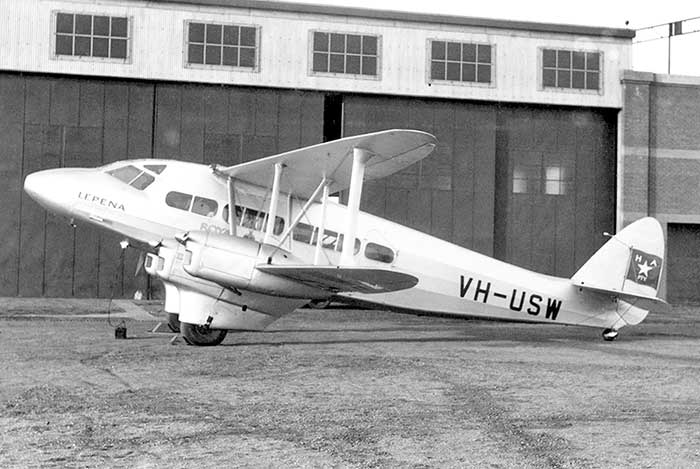
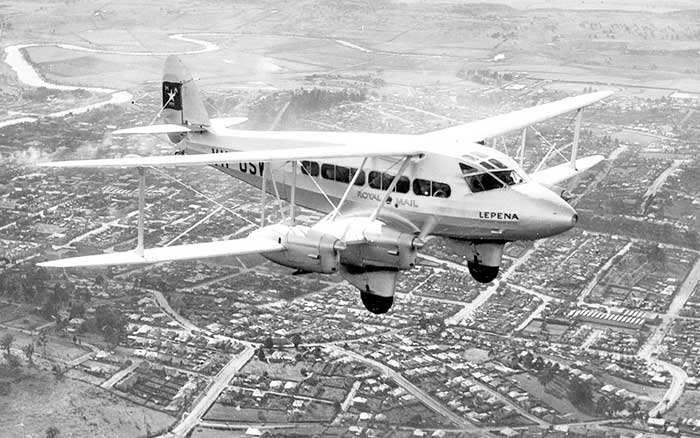
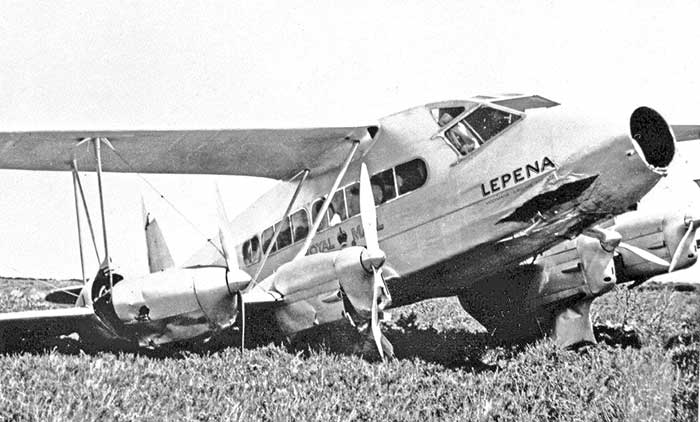
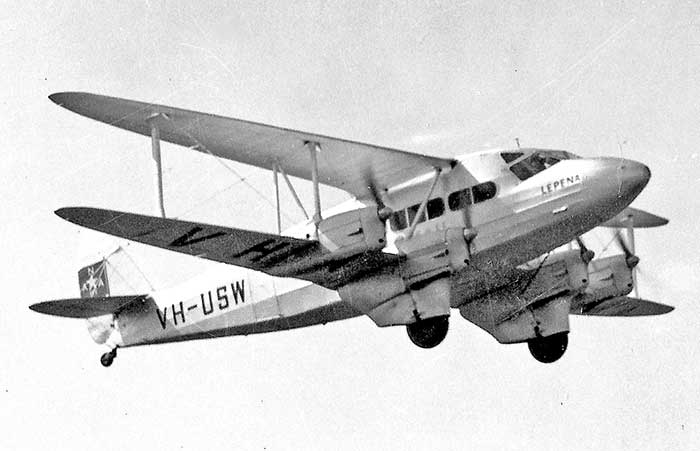
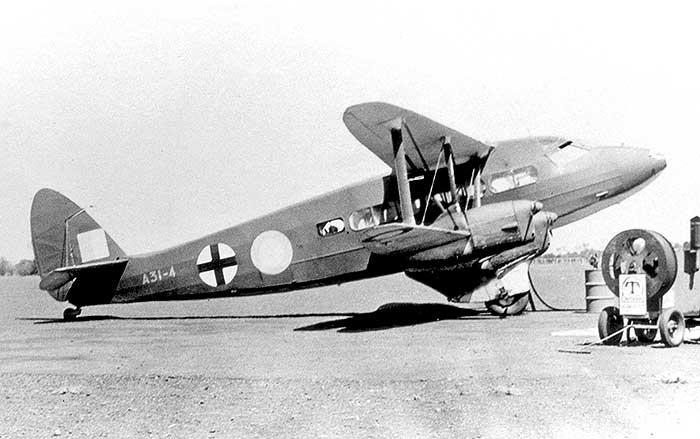
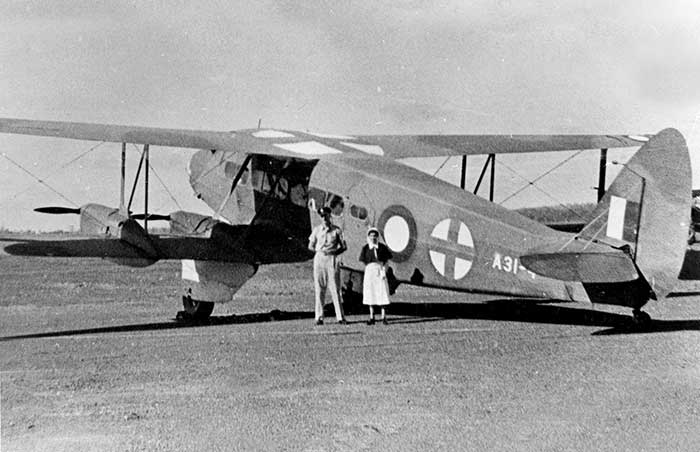
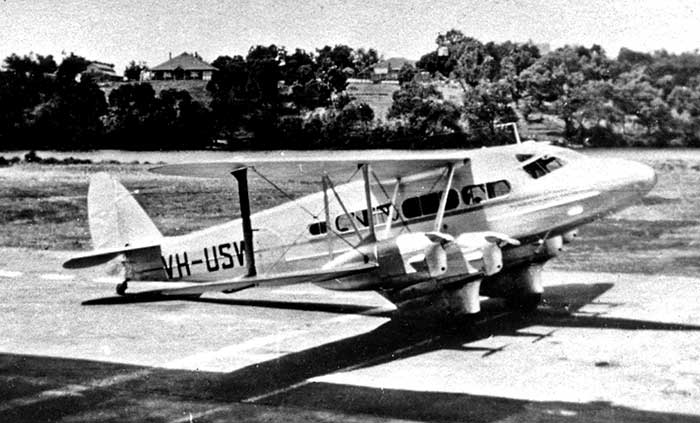
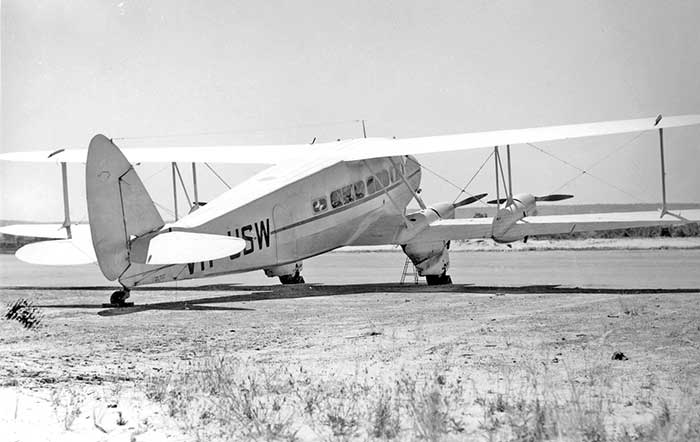
It was abandoned by its crew in India en route. Geoff
Goodall collection
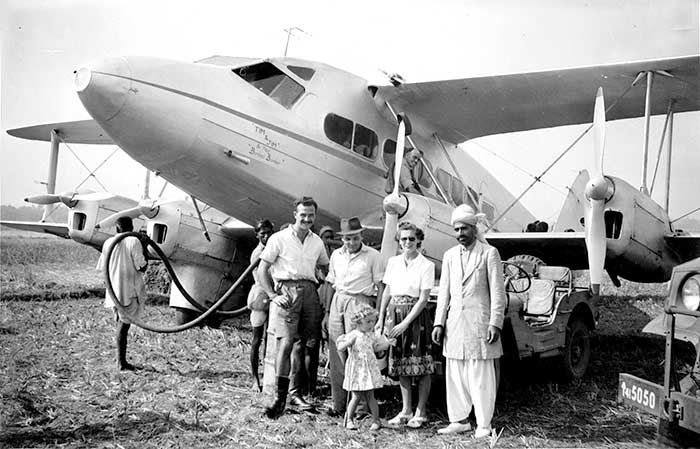
Hand-painted on the nose by the two British ferry pilots was "Tim & Jim and their Bamboo Bomber".
Here one pilot poses with friends, but the pair were increasingly concerned with tail flutter and were soon to
refuse to continue, abandoning the DH.86 at Allahabad, India Photo via Frank Colqhoun collection
| 7.35 |
Built at Hatfield by De Havilland Aircraft Co Ltd. Production DH.86A |
| Ordered by Holyman’s Airways Pty Ltd through agents De Havilland Aircraft Pty Ltd, Mascot which handled shipping and import | |
| 28.5.35 |
CAB allocated registration VH-UUB. Painted with Australian registration in the factory. |
| 15.7.35 |
British CofA issued VH-UUB: Holyman’s Airways Pty Ltd, Launceston Tasmania |
| Shipped to Australia |
|
| 9.35 |
Assembled at RAAF Laverton Vic |
| 23.9.35 |
First flight Laverton after assembly, pilot Captain Allan Murray Jones of DHA |
| 25.9.35 |
CAB Inspection Report at Laverton. Airframe time 2 hrs 10 mins |
| 27.9.35 |
Australian CofA issued |
| 27.9.35 |
Added to Register VH-UUB: Holyman’s Airways Pty Ltd, Launceston Tas. Named Loila |
| 18.7.36 |
Inspection report at Essendon, test flown same day Captain C. H. Scott. Airframe time 1944 hrs |
| 7.11.36 |
Change of ownership due merger: Australian National Airways Pty Ltd, Melbourne Vic Retained the same name Loila |
| 3.12.36 |
Damaged during forced landing near Seymour Vic due poor weather. Struck a fence. Captain A. M. Bayne, 7 passengers unhurt |
| 31.3.38 |
Departed Essendon on a charter flight to Alice Springs and Ayers Rock. Returned 4.4.38 |
| 27.4.38 |
Annual CofA renewal completed at Essendon. Test flown same day Captain C. H. Scott Airframe time 3791 hrs |
| 22.10.38 |
Port undercarriage collapsed landing Essendon when aircraft swung off the landing strip. Wings and propellers damaged. Captain A. J. Brown, 10 passengers |
| 13.1.39 |
Port undercarriage collapsed due to a ground-loop on takeoff Canberra ACT. Captain W. D. Wedgewood and 1 passenger, no injuries |
| 10.3.39 |
Annual CofA renewal completed at Essendon. Test flown same day Captain C. H. Scott Airframe time 4946 hrs |
| 3.11.39 |
DCA Inspection Report at Mascot to assess condition and
availability for impressment. Total airframe time 5837 hrs. Condition good, a new nose had been fitted 5.3.40 |
| 23.12.39 |
Starboard undercarriage collapsed during landing Launceston when aircraft was struck by a wind gust. Captain D. Barker and 12 passengers, no injuries. Scheduled Melbourne-Launceston service. |
| 6.3.40 |
Forced landing Essendon due engine problem, no damage. Captain F.T. Patterson |
| 11.3.40 |
Forced landing on a beach near Southport Qld due low fuel state, no damage. Captain F. T. Patterson. The 9 passengers were taken to Brisbane by road, and VH-UUB was flown out to Archerfield later that day by Captain Patterson |
| 6.7.40 |
Impressment Requisition No.8169 was served on ANA by Australian Government for VH-UUB, and No.8170 for VH-USW. Both to be delivered by ANA to Essendon on 13.9.40 where they are to be handed over to the Commanding officer of No.3 EFTS. |
| 25.7.40 |
VH-UUB Inspected Report at Archerfield. Airframe time 7109 hrs |
| 4.9.40 |
Returned to Archerfield after departure due u/s wireless transceiver. Captain A. Gilbertson of Airlines of Australia, 4 passengers. Operating an AoA service. (Airlines of Australia had merged operations with ANA) |
| 12.9.40 |
A tyre on VH-UUB was punctured at Mackay Qld. The flat tyre due delayed the scheduled Airlines of Australia Brisbane-Cairns service |
| 13.9.40 |
Taken on RAAF charge as DH.86A A31-3. Received 3EFTS ex ANA |
| 9.40 |
Issued to Ansett Airways, Essendon for RAAF pre-delivery overhaul and modifications |
| 2.11.40 |
A31-3 Inspection report at Essendon after overhaul for RAAF. Airframe time 7574 hrs |
| 4.11.40 |
Ready for collection at ANA, Essendon |
| 5.11.40 |
Received 1AD Laverton ex 3EFTS Essendon |
| 10.11.40 |
Issued No.1 Air Observers School, Cootamundra ex 1AD |
| 9.12.40 |
Serviceable at 1AOS |
| 3.2.41 |
Allotted to No.1 Air Ambulance Unit |
| 14.2.41 |
Received 1AD Laverton ex 1AOS |
| 3.4.41 |
Issued ANA Essendon for modifications ex 1AD |
| 10.4.41 |
Ready for collection at ANA |
| 13.4.41 |
Serviceable in 3 days at 1AD |
| 21.4.41 |
Pilot log book: A31-3 local flying RAAF Laverton, pilot P/O B.D.Bates |
| 24.4.41 |
Issued to 1AAU ex 1AD |
| 25.4.41 |
Arrived at ANA workshops at Essendon from Laverton “for completion of screening and other work - being completed on 28.4.41” |
| 5.41 |
RAAF 13 Squadron Operations Record Book: “From 02 to 05 May, Geoff Sattler flew to Drysdale Advanced Operational Base WA to provide communication, refuelling, maps and other facilities for a DH86 Air Ambulance on its way to the Middle East. The DH86 had a limited range for the short hop from Drysdale to eastern Java. Its captain was F/Lt. K. McDonald, a former pilot of the flying classroom DH86 at Signals School at Point Cook.” (Believed to have been A31-3 but not confirmed) |
| 5.41 |
1AAU DH.86s A31-3 and A31-7 departed Drysdale WA for the Timor Sea
crossing on delivery to Egypt. The delivery flight was delayed by
engine and instrument troubles, weather and crew illness. |
| 1.2.42 |
A31-3 and A31-7 both damaged on the ground at El Adem by enemy bombing |
| Both moved to British Air Repair Unit at Heliopolis for repaits |
|
| 19.4.42 |
Destroyed by fire at Heliopolis Aerodrome. Struck by RAF Beaufighter X7804, which swung on takeoff due engine failure. |
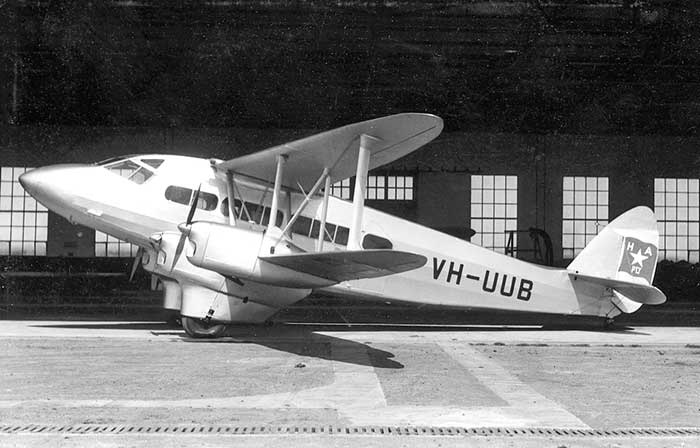
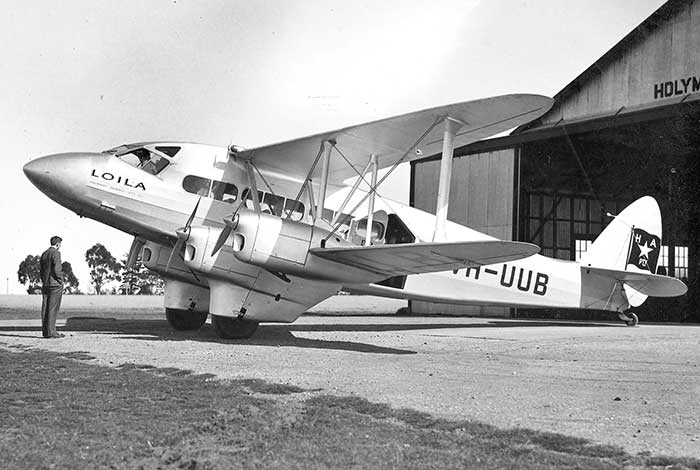
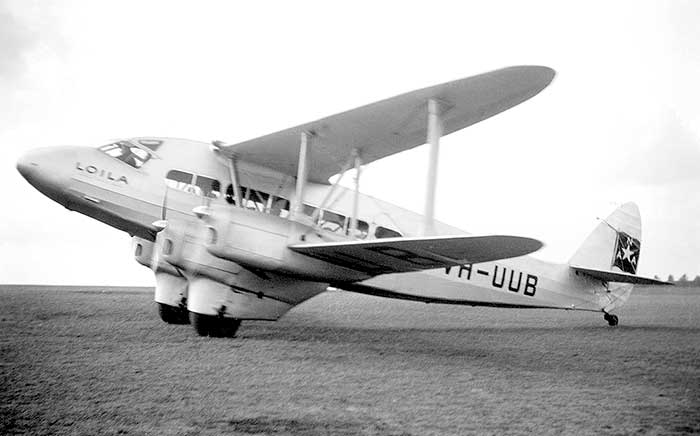
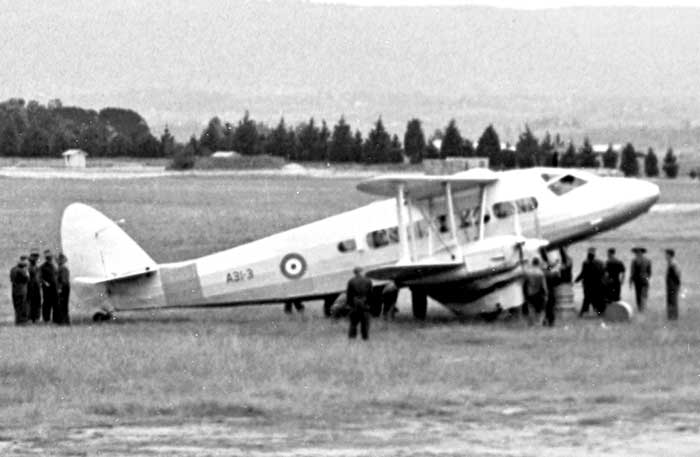
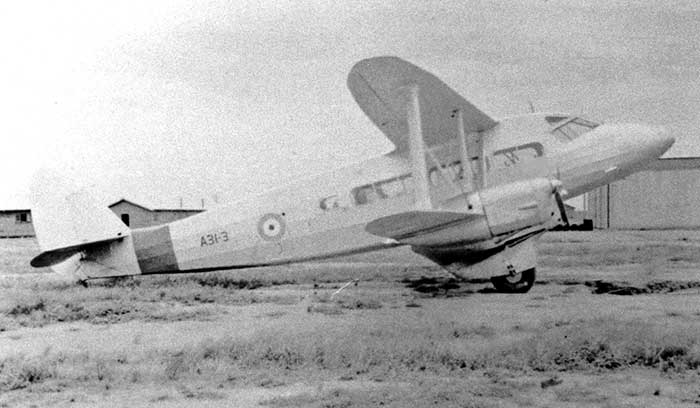
| 11.37 |
Built at Hatfield by De Havilland Aircraft Co Ltd. Production DH.86B |
| Order
for three new DH.86B placed by W.R.Carpenter & Co Ltd, Sydney
through the Australian company De Havilland Aircraft Pty Ltd at Mascot
which would handle their shipping to Australia, import and assembly at
Mascot |
|
| 22.6.37 |
CAB responded to a request from De Havilland Aircraft Pty
Ltd for Australian registrations for the three DH.86Bs: allocated VH-UYU, VH-UYV & VH-UYW. Australian registrations were painted on the airframes at the DH factory |
| 30.11.37 |
British CofA issued VH-UYU: W.R.Carpenter & Co Ltd, Sydney |
| Shipped to Australia |
|
| Assembled at Mascot Aerodrome, Sydney |
|
| 10.3.38 |
Added to Register VH-UYU: W.R.Carpenter & Co Ltd, Mascot Aerodrome, Sydney To be operated by W. R. Carpenter Airlines. Named RMA Carmania |
| 10.3.38 |
Australian CofA issued |
| 10.3.38 |
Alan
Murray Jones of De Havilland Aircraft Pty Ltd flew VH-UYU at Mascot to
endorse Captain R.O.Mant, Flight Superintendent of W.R.Carpenter
Airlines on the new type |
| 10.3.38 |
Pilot logbook Ken Jackson: endorsement flight at Mascot with Captain Dick Mant. |
| 12.3.38 |
Crew training flights at Mascot by Captains Mant and Jackson. Also 24.3.38 |
| 15.3.38 |
VH-UYU departed Mascot on a survey flight along the W.R.Carpenter Airlines’ recently approved airline route Sydney to Brisbane, Rockhampton, Townsville, Cairns, Cooktown, Port Moresby, Salamaua to Rabaul. This survey was flown by the airline Flight Superintendent Captain Richard O.Mant accompaniued by pilots Ken Jackson, Nobby Clark, Sammy Hall. Joss Crisp of Mandated Airlines joined them at Port Moresby and pilot training was conducted along the route. |
| DCA
approval to commence of the scheduled airline service was delayed due
to problems with the Lorenz radio beacon navigation aids which had just
been installed at Sydney, Brisbane, Townsville, Cooktown and Salamaua.
Radio communications between the Dh.86s and ground stations was by Morse Code only |
|
| 30.5.38 |
VH-UYU departed Mascot on the inaugural airmail of the
Sydney-Salamaua-Rabaul service, Captain R.O.Mant and First Officer K.G.Jackson. Passengers included Minister for Territories, W.M.Hughes and officials from the Department of External Affairs. At Salamaua northbound, Jackson was taken to hospital with malaria. Manadated Airlines pilot Eddie Sutcliffe replaced him as F/O for the rest of the service. Arrived Rabaul 1.6.40 |
| 38-41 |
Operated on the W.R.Carpenter Airlines services between Sydney and Rabaul |
| 6.7.40 |
Director General of Civil Aviation wrote to W.R.Carpenter
advising that it is not intended that VH-UYU will be impressed for RAAF at this time |
| 7.5.41 |
DCA internal memo: “it is anticipated VH-UYU will be impressed from Carpenters for ambulance conversion some time this month.” This was due to RAAF requirement for ambulance aircraft. |
| 5.41 |
Impressment Requisition No.9012 served on W.R.Carpenter for DH.86 VH-UYU |
| 20.6.41 |
Taken on RAAF charge as DH.86B A31-8. Received at 3EFTS Essendon from W.R.Carpenter Allocated to ANA Essendon for mods for ambulance duties |
| 22.8.41 |
Received 1AD Laverton ex ANA, for service with No.1 Air Ambulance Unit |
| 8.41 |
Allotted to 1AAU serving in Middle East |
| 8.41 |
Ferried from Australia to Egypt to join 1AAU in the Western Desert campaign |
| 8.12.41 |
Destroyed by enemy attack at Landing Ground LG138 near Libya border. Flg. Off. Duffield in was twice attacked near LG138, where he landed with the rear fuselage and port wing petrol tank on fire and some flying controls shot away. The DH.86 was a complete loss, a nursing orderly wounded and Duffield injured. |
| 8.12.41 |
Authorised for write off |
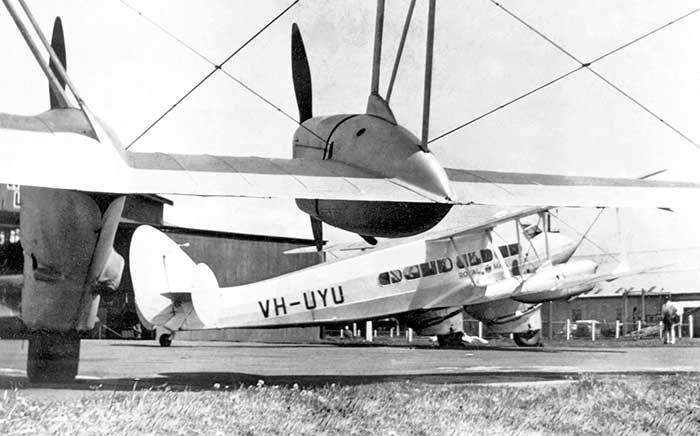
Photo: The Collection p1234-2772
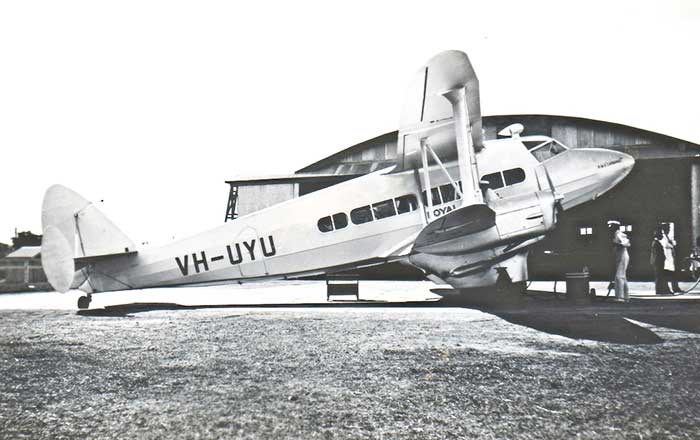
Photo: Gus Grulke collection
| 12.37 |
Built at Hatfield by De Havilland Aircraft Co Ltd. Production DH.86B |
| Order for three new DH.86B ordered by W.R.Carpenter & Co Ltd, Sydney through the Australian company De Havilland Aircraft Pty Ltd at Mascot which would handle their shipping to Australia, import and assembly at Mascot Aerodrome, Sydney | |
| 22.6.37 |
CAB responded to a request from De Havilland Aircraft Pty
Ltd for Australian registrations for the three DH.86Bs: allocated VH-UYU, VH-UYV & VH-UYW. Australian registrations were painted on the airframes at the DH factory |
| 18.12.37 |
British CofA issued VH-UYV: W. R. Carpenter & Co Ltd, Sydney NSW |
| Shipped to Australia |
|
| 2.38 |
Assembled at Mascot |
| 8.3.38 |
Test flown at Mascot after assembly |
| 8.3.38 |
Added to Register VH-UYV: W. R. Carpenter & Co Ltd, Sydney NSW To be operated by W. R. Carpenter Airlines. Named RMA Coronia |
| 8.3.38 |
Australian CofA issued |
| 19.3.38 |
Pilot logbook Ken Jackson:
Sydney-Salamaua with Flight Superintendent R.O,Mant, to position VH-UYV
at Salamaua as stand-by aircraft. Both pilots returned to Sydney by sea. |
| 38-39 |
Flown on Carpenter Airlines’ airmail route Sydney-Rabaul |
| 10.5.39 |
Returned to Cooktown Qld after takeoff for Port Moresby due
engine trouble. No damage. Captain R.O.Mant (Carpenter Airlines Flight Superintendent), 5 passengers |
| 4.12.39 |
Impressment Requisition No.12502 served on W.R.Carpenter & Co Ltd for one DH.86, either VH-UYV or VH-UYW at the owner’s option. To be delivered to RAAF Station, Laverton on Monday, 11th December, 1939 |
| 11.12.39 |
Taken on RAAF charge as DH.86B A31-1. Received at No.1 Flying Training School Signal School, Point Cook ex W.R.Carpenter |
| 3.40 |
Wireless Courses organised by the Signal School were commenced at Point Cook in 3.40, using A31-1, which flew 29 hrs of instruction that month. Courses continued in April also using an Anson aircraft (A31-1 54 hrs) and May 1940 (A31-1 29 hrs) |
| 26.4.40 |
Serviceable at Signal School, Point Cook |
| 23.9.40 |
Pilot log: A31-1local flying RAAF Point Cook, “flying classroom ex Carpenters” |
| 24.9.40 |
Pilot log: A31-1 Point Cook-Ballarat-Point Cook-Essendon. Crew F/O J.G.McDonald, F/O A.D.McCormack and Sqn Ldr D.J.McPherson |
| 40-42 |
Remained with Signal School until 9.42, routine services, engine changes and minor repairs |
| 17.3.41 |
Issued to Ansett Airways at Essendon for complete overhaul |
| 4.6.41 |
Issued Signals School, Point Cook ex Ansett Airways |
| 4.5.42 |
Point Cook Operations Record Book: A31-1 departed at 4pm for Essendon |
| 9.5.42 |
Point Cook ORB: A31-1 arrived at 2200 from Launceston |
| 28.8.42 |
Point Cook ORB: A31-1 departed for Cressy at 1600, returned 1715 |
| 15.9.42 |
Point Cook ORB: A31-1 departed at 1513 for Essendon |
| 16.9.42 |
Received 36 Sqn Laverton ex Signal School |
| 29.10.42 |
Point Cook ORB: A31-1 arrived from Essendon, departed at 1430 |
| 10.11.42 |
Received ANA Essendon ex 36 Sqn for complete overhaul |
| 20.12.42 |
Allotted 36 Sqn rear echelon ex ANA Essendon |
| 42 |
Directorate of Air Transport, Allied Air Forces allocate radio callsign VHCSD, which was painted on the aircraft |
| 2.1.43 |
Allotted 34 Sqn Parafield ex 36 Sqn. |
| 14.1.43 |
Issued to Guinea Airways Parafield ex 34 Sqn for repair |
| 26.3.42 |
Received 34 Sqn ex Guinea Airways via 1EFTS Parafield |
| 24.5.43 |
Issued 35 Sqn Pearce ex 34 Sqn |
| 31.5.43 |
RAAF Cunderdin Operations Record Book: DH86 VHCFD Maylands-Cunderdin-Kalgoorlie. Next day returned Kalgoorlie-Cunderdin-Maylands. (Assumed clerical error for VHCSD) |
| 8.6.43 |
Issued to MacRobertson Miller Aviation, Maylands ex 35 Sqn for servicing |
| 4.8.43 |
Received 35 Sqn Pearce ex MMA |
| 19.1.44 |
Received No.2 Air Ambulance Unit, Kingaroy ex 35 Sqn. 2AAU to carry out modification to convert aircraft to air ambulance |
| 15.8.44 |
Crashed on takeoff. Port tyre blew out on takeoff, major damage. Pilot F/O C.D.Nicholls and 3 crew unhurt. Airframe total time 4269 hrs |
| 23.8.44 |
Issued 6AD Oakey ex 2AAU |
| 12.9.44 |
Approved for conversion to components |
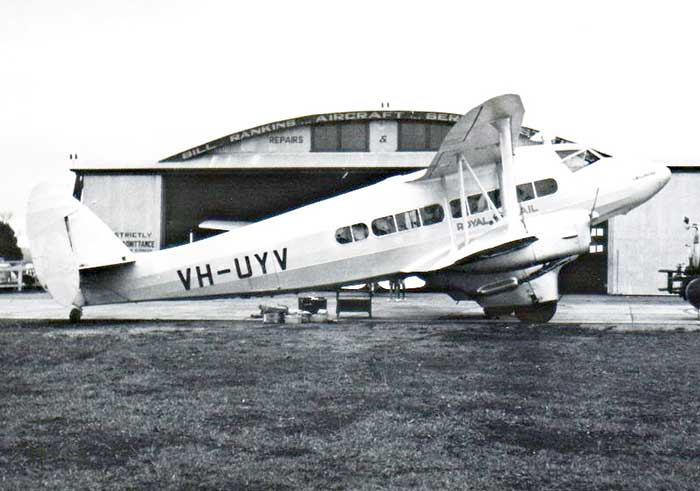
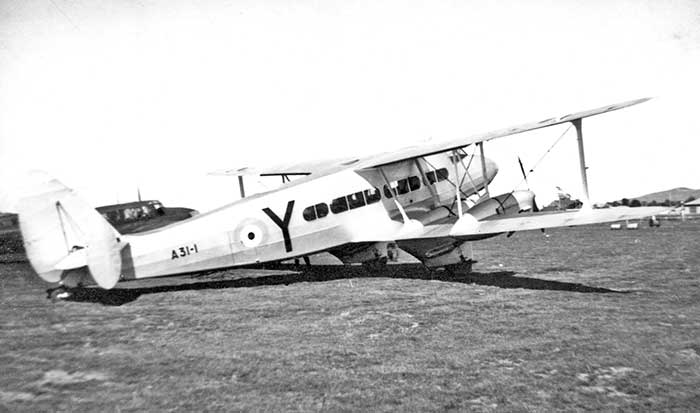
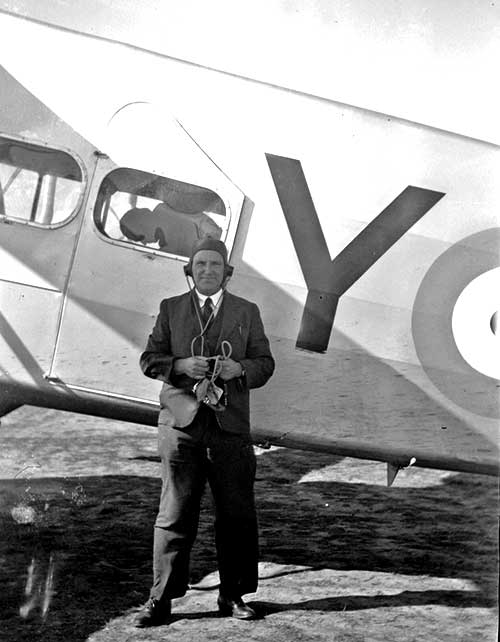
A civilian radio technician with A31-1 at Point Cook while installing W/T equipment
Photo: Maurice Austin collection
| 12.37 |
Built at Hatfield by De Havilland Aircraft Co Ltd. Production DH.86B |
| Order for three new DH.86B ordered by W.R.Carpenter & Co Ltd, Sydney through the Australian company De Havilland Aircraft Pty Ltd at Mascot which would handle their shipping to Australia, import and assembly at Mascot Aerodrome, Sydney | |
| 22.6.37 |
CAB responded to a request from De Havilland Aircraft Pty
Ltd for Australian registrations for the three DH.86Bs: allocated VH-UYU, VH-UYV & VH-UYW. Australian registrations were painted on the airframes at the DH factory |
| 30.12.37 |
British CofA issued VH-UYW: W. R. Carpenter & Co Ltd, Sydney NSW |
| Shipped to Australia |
|
| Assembled at Mascot by De Havilland Aircraft Pty Ltd | |
| 9.5.38 |
Added to register VH-UYW: W. R. Carpenter & Co Ltd, Mascot Aerodrome, Sydney NSW To be operated by W. R. Carpenter Airlines. Named RMA Carinthia |
| 9.5.38 |
Australian CofA issued |
| 38-40 |
Flown on Carpenter Airlines’ airmail route Sydney-Rabaul |
| 10.38 |
Fabric was torn off the cockpit roof by severe weather between Salamaua and Port Moresby. Captain R.O.Mant lost control of the aircraft when it was caught in a strong uprush of air and entered a layer of sleet and snow, which covered the airframe in ice. Mant told the press "It was the worst storm in my experience - it simply hammered us". Critics pointed out the vulnerability of fabric-covered biplanes on the airline service to Australia |
| 15.3.40 |
Ditched in sea off Kavieng, New Ireland. Departed Salamaua at 6.50am on a scheduled airline service to Rabaul, with full fuel tanks. The crew was unable to reach Rabaul due monsoonal weather, diverted to Kavieng, but ran out of fuel. Rain entering the cockpit had disabled the wireless. Ditched 400 yards offshore and sank, the occupants, mails and freight were taken to land by native canoes. Captain Ken G. Jackson and First Officer Clive R. Bernard, engineer H.C.Adrian and five passengers escaped injury. |
| Captain Jackson's report to DCA stated in part: "At 1145 hours I became doubtful as to the possibility of reaching Kavieng owing to shortage of fuel. At 1150 hours both port engines stopped and I decided to alight on the water. I told the Engineer to prepare the passengers and to be ready to open emergency hatches etc. The aircraft struck the water tail first at about 60mph and then the main undercarriage, which caused the aircraft to submerge nose first to a depth of about approximately 10 feet, from which, after losing its forward speed, it returned to the surface, the cabin being partially under water. When I emerged from the cockpit, all passengers and crew were standing on top of the fuselage. Life-belts and the collapsible boat were then inflated. Native canoes were approaching, and three passengers embarked in the boat and set out for shore. The remaining passengers, crew, mails and freight were taken ashore by native canoes." |
|
| Captain Ken Jackson much later recalled the event in an interview with historian Greg Banfield: "We ran into a very heavy monsoonal storm. Rabaul is almost a land-locked harbour with just a small entrance and I had to fly along the coast to try to find the harbour entrance to get in under the low cloud. As there we no radio aids you had to be able to see your way in. I made four attempts to find Rabaul harbour before I was forced to divert to the nearest emegency aerodrome at Kavieng, about 120 miles away. About 30 miles short of Kavieng, our poetrol ran out. I chose to land inside a reef on smooth water, only about a quarter of a mile off-shore. I was a bit worried that with the fixed undercarriage, the aircraft would cart-wheel when we hit the water, but I just levelled out and in we went. In the landing I hit my head on the canopy and was knocked unconscious. When I came to, my head was under water. My nose came out of the water and I felt a whiff of air and after a few gulps of air my senses returned. I opened the cabin door, but all the passengers were gone, having climbed out on top of the aeroplane. A few native canoes came out and took us all ashore. The aircraft floated for about 40 minutes and we removed all the mail, luggage and gear before it sank in 100 feet of water." |
|
| The DH.86 sank and settled at a depth of 110 feet. Insurance wrote-off the aircraft |
|
| 3.40 |
A
week after the ditching, the aircraft was salvaged by Frank Saunders of
Kavieng, who brought the aircraft to the surface using his schooner Navanora.
However the wood and fabric construction collapsed
while being lifted by the grappling gear. The majority of the aircraft
was loaded on the deck. However it was damaged beyond repair |
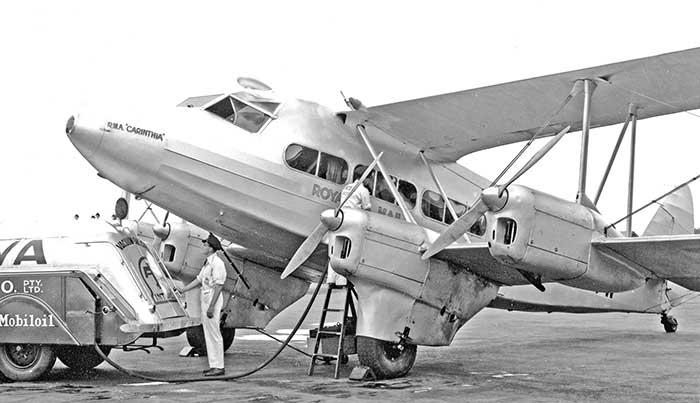
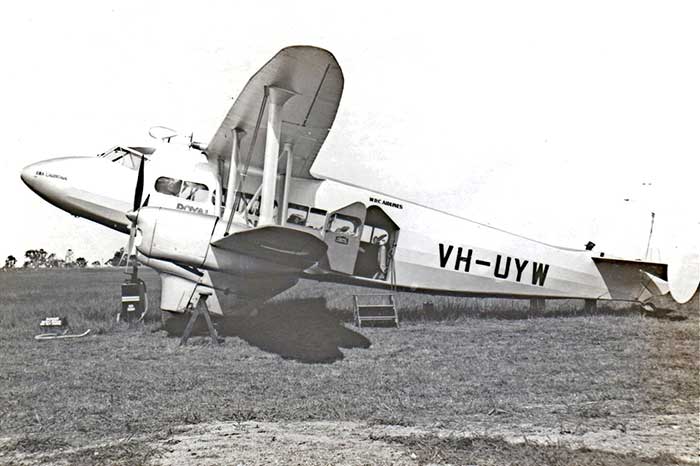
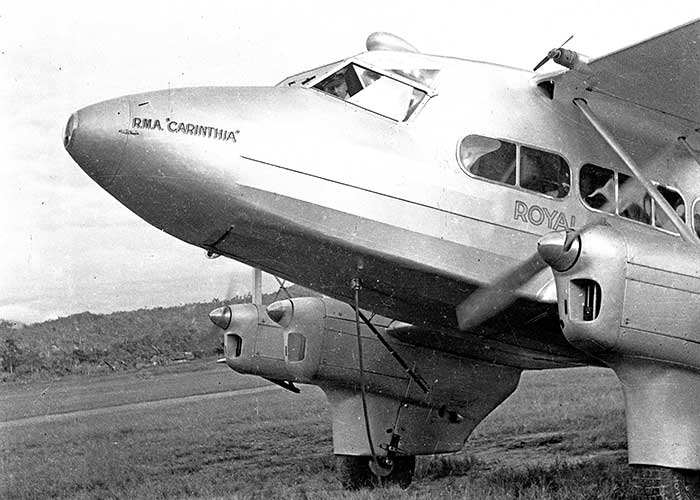
| 1.35 |
Built ast Hatfield. Production DH.86 |
| 6.2.35 |
CofA issued G-ACYF Jersey Airways Ltd, Jersey. Named Giffard Bay |
| Modified to DH.86A standard |
|
| 6.38 |
Repainted at Jersey as VR-SBD in Wearne’s Air Servces markings, ready for ferry flight to Singapore |
| 6.38 |
Registered VR-SBD Wearne’s Air Services Ltd, Singapore. Named Governor Murchison |
| 7.7.38 |
Under command of pilots Pugh and Beresford, DH.86s VR-SBC and VR-SBD departed Heston at 3.47am for Marseilles on their delivery flights to Singapore |
| 4.40 |
W.R.Carpenter Airlines Flight Superintendent Captain R. O. Mant travelled to Singapore by Qantas scheduled flying boat service to finalise the purchase of two DH.86s from Wearne’s Air Services |
| 4.40 |
Sold to W. R. Carpenter & Co Ltd, Sydney NSW |
| 16.4.40 |
Wearne’s Air Services completed a full overhaul prior to departure on ferry flight to Sydney. Airframe hours at time of sale was 2871 hrs |
| 26.4.40 |
VR-SBD departed Singapore on delivery flight to Sydney, pilot Captain R.O.Mant |
| 3.5.40 |
arrived Mascot after delivery flight from Singapore. |
| 7.5.40 |
DCA allocated registration VH-ADN to the first of Carpenter’s DH.86s from Singapore |
| 5.40 |
Australian CofA inspection by De Havilland Aircraft Pty Ltd at Mascot |
| 21.5.40 |
DCA Mascot office memo: “The first of the two DH.86 aircraft which W.R.Carpenter & Co were granted approval to import from Singapore is now ready for operation. Registration VR-SBD for which VH-ADN has been allocated." |
| 27.5.40 |
Added to Register VH-ADN: W. R. Carpenter & Co Ltd, Sydney To be operated by W. R. Carpenter Airlines route between Sydney and Rasbaul, New Britain |
| 27.5.40 |
Australian CofA issued |
| 5.40 |
Impressment Requisition No.12526 served on W.R.Carpenter & Co for VH-ADN for issue to RAAF. This aircraft and spare engine and spare parts to be delivered to Essendon and handed over to Commanding Officer 3EFTS by a normal operating crew at a date to be advised |
| 6.6.40 |
Departed Sydney on its first service on Carpenter Airlines’ scheduled service to Rabaul |
| 8.7.40 |
DCA Mascot office cable to DCA Head Office: “Carpenters handing over DH86 VH-ADN to RAAF 9 July 1940” |
| 8.7.40 |
Ferried Mascot-Essendon by Carpenters on delivery to RAAF |
| 9.7.40 |
Taken on RAAF charge as DH.86B A31-2. |
| 9.7.40 |
Received at Ansett Airways workshop, Essendon for mods prior to RAAF service |
| 9.7.40 |
VH-ADN Struck-off Civil Register |
| 1.8.40 |
DCA inspection report of “RAAF aircraft VH-ADN” while under overhaul at Essendon. Airframe had flown only 157 hours since overhaul by Wearne’s Air Services in Singapore. Ansett Airways had found a number of defects, and DCA issued a civil Rectification of Inspection Report form requiring them to be corrected prior to completion of inspection |
| 18.11.40 |
RAAF Status Card: Ready for collection at Ansett Airways. Allotted to 1AOS Cootamundra |
| 19.11.40 |
Test flown Essendon after overhaul by Ansett, RAAF Pilot Officer Douglas E. Barka |
| 21.11.40 |
Inspection Report at Essendon completed by Ansett Airways |
| 2.12.40 |
Serviceable at 1AOS Cootamundra |
| 9.12.40 |
Damaged on landing at Cootamundra NSW, lower port wing dug into ground when aircraft caught by a severe wind gust. Damage to port upper and lower outer mainplanes. P/O D.E.Barker |
| 40-42 |
Air crew trainer duties at 1AOS, Cootamundra |
| 13.3.42 |
Status Card: Received Point Cook ex 1AOS Point Cook Operations Record Book: A31-2 arrived Point Cook ex Cootamundra at 10.15 am, F/O Berry. |
| 16.3.42 |
Point Cook ORB: Flt.Lt. Burdue and crew departed for Swan
Hill at 9.10 am – returned to Point Cook at 6.21 pm that day |
| 21.3.42 |
Received 1AD Laverton ex Point Cook |
| 29.5.42 |
Received Signal School, Point Cook ex 1AD |
| 20.7.42 |
U/S at 1SFTS Point Cook, minor repairs |
| 21.9.42 |
Received 36 Sqn Laverton ex Point Cook |
| 26.10.42 |
Point Cook ORB: arrived from Essendon, departed 4.20pm |
| 2.12.42 |
Seriously damaged when ground-looped on landing at Wagga from Essendon, enroute to Townsville. Crew Sgts Owen, Mortimer and Haxton, plus Brooks and Proud. |
| 4.12.42 |
Received 5AD Wagga ex 36 Sqn |
| 4.1.43 |
4Issued to De Havilland Aircraft, Mascot ex 5AD for repair |
| 23.3.42 |
Received No.2 Aircraft Park, Bankstown ex DH |
| 3.4.43 |
Received 34 Sqn Parafield ex 2AP |
| 43 |
Directorate of Air Transport, Allied Air Forces allocated radio callsign VHCSE, which was painted on the aircraft |
| 14.5.43 |
Issued Guinea Airways, Parafield ex 34 Sqn for service |
| 30.5.43 |
Issued 35 Sqn Pearce ex Guinea Airways |
| 1.9.43 |
Issued MMA Maylands ex 35 Sqn for service |
| 16.3.44 |
Allotted to 2AAU ex MMA on completion. 2AAU to carry out modification to air ambulance |
| 18.3.44 |
RAAF Cunderdin Operations Record Book: DH86 VHCSE arrived Cunderdin, departed for Kalgoorlie. |
| 1.5.44 |
Crashed during forced landing 1 mile from Maryborough Qld. Damage to fuselage, wings, tailplane, wheel spats, port outer propellers, ailerons. Forced landing due fuel exhaustion. |
| 6.5.44 |
No.13 Aircraft Repair Depot, Breddan Qld to despatch salvage party, 2 members to
escort rail crash tender from Townsville, remainder proceed by passenger train with tools. Dismantle aircraft and prepare for rail |
| 13ARD advise aircraft not repairable, request allot to southern depot for salvage | |
| 30.5.44 |
Received No.3 Central Recovery Depot, Amberley ex 2AAU for conversion |
| 1.8.44 |
Approved for conversion to components. The four engines, four propellers and the fin bias actuating screw and nut are to be held at 3CRD pending further advice |
| 9.10.44 |
Normal action for conversion may proceed. Cancel 1.8.44 instruction re certain parts |
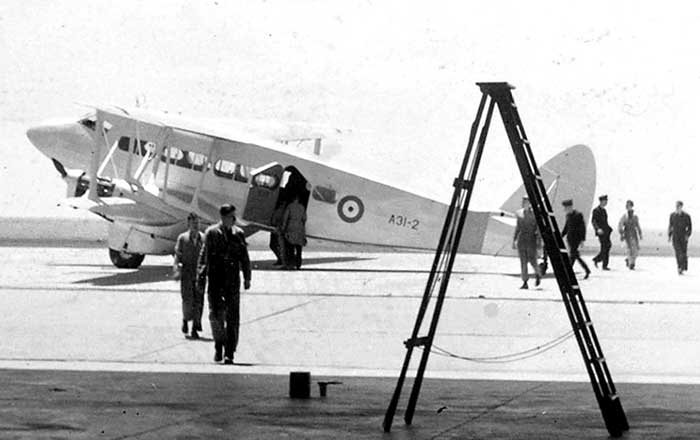
Here it is at Ansett Airways hangar at Essendon in November 1940 after overhaul and repaint for RAAF.
Photo: Civil Aviation Historical Society
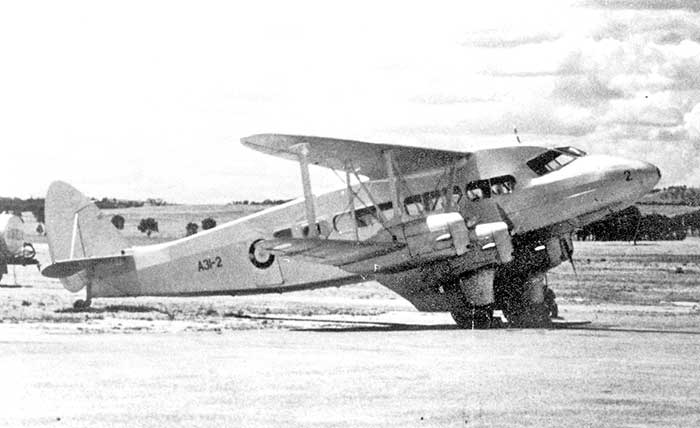
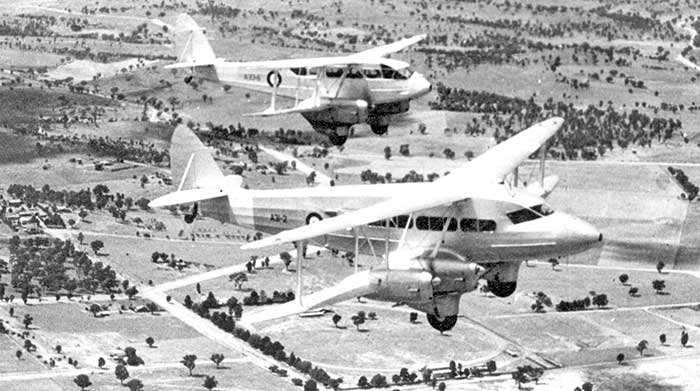
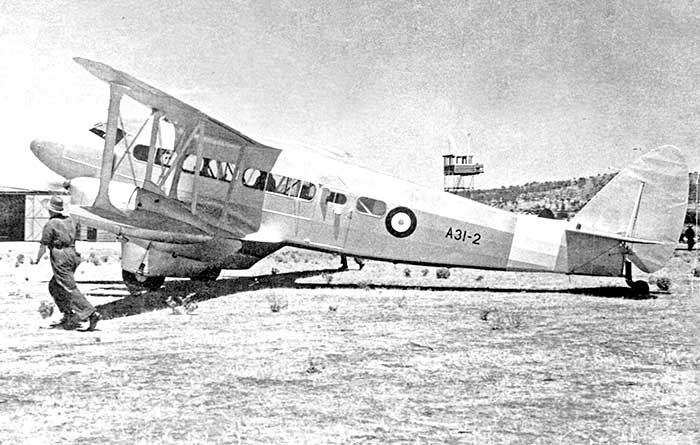
| 5.35 |
Built at Hatfield. Production DH.86 |
| 3.6.35 |
First flight Hatfield |
| 5.6.35 |
CofA issued G-ADEA Hillman’s Airways Ltd, Maylands, Essex. Named Drake |
| 11.12.35 |
Hillman’s Airways was purchased by British Airways |
| 12.35 |
Change of ownership: British Airways Ltd, Gatwick |
| 10.37 |
Change of ownership: Airwork Ltd |
| Modified to DH.86A standard |
|
| 6.38 |
Sold to Wearne’s Air Service Ltd, Singapore |
| 7.38 |
Registered VR-SBC: Wearne’s Air Service Ltd, Singapore. Named Governor Ibbotson |
| 7.7.38 |
VR-SBC and VR-SBD departed Heston at 3.47am for Marseilles on their delivery flights to Singapore under the command of Captains Pugh and Beresford |
| 39 |
Early in the year VR-SBC made a survey flight across the South China Sea to the British Protectorate Sarawak, to demonstrate feasibility of an air service to the British-administered territories in northern Borneo |
| 4.40 |
W.R.Carpenter Airlines Flight Superintendent Captain R. O. Mant travelled to Singapore by Qantas scheduled flying boat service to finalise the purchase of two Wearne’s Air Services DH.86As |
| 4.40 |
Sold to W. R. Carpenter & Co Ltd, Sydney |
| 11.6.40 |
Singapore CofA renewed by Wearne’s Air Service |
| 13.6.40 |
Departed Singapore on delivery flight to Sydney, pilot Captain R.O.Mant |
| 22.6.40 |
De Havilland Aircraft Pty Ltd at Mascot Aerodrome, Sydney wrote to DCA: their company carries out all aircraft maintenance and assembly for W.R.Carpenter. They request approval for VR-SBC to operate the WRC Airlines service Sydney-Rabaul leaving Sydney 27.6.40 prior to formal Australian registration. The aircraft is urgently needed and DHA will certify that it is airworthy. No written reply from DCA but the request was dropped |
| 17.7.40 |
Test flight at Mascot after inspection, WRC Captain E. D. Crisp. Airframe time: 3,145 hrs |
| 17.7.40 |
Added to Register VH-UZX: W. R. Carpenter & Co Pty Ltd, Mascot Aerodrome, Sydney. To be operated by W.R.Carpenter Airlines |
| 17.7.40 |
Australian CofA issued |
| 7.40 |
Commenced service on the airline’s Sydney-Salamaua-Rabaul airmail service |
| 15.12.40 |
Engine failed during ground run-up at Salamaua, New Guinea, no damage. Captain K. G. Jackson, 2 passengers, no injuries |
| 27.12.40 |
Impressment Requisition No.8192 served on W.R.Carpenter
& Co Pty Ltd for VH-UZX. The aircraft is to be delivered by a normal operating crew to 3EFTS Essendon on 2.1.41 |
| 2.1.41 |
Taken on RAAF charge as DH.86A A31-7. Received at 3EFTS Essendon ex W.R.Caroenter & Co |
| 5.1.41 |
Issued to ANA Essendon for modifications for air observer school use |
| 28.1.41 |
DCA Inspection Report at ANA hangar, Essendon. Total airframe time 3,905 hrs. Report states: “This aircraft is considered to be in a better condition than VH-USW or VH-UUB, but not so good as VH-ADN, Carpenter’s other D.H.86 previously impressed, nor as good as the Qantas D.H.86 VH-USF. It is better than Miller’s D.H.86 VH-USC.” |
| 31.1.41 |
F/O Higgins advised DCA that conversion work at present being carried out on this aircraft for air observer training was to be discontinued, because it was “proposed to equip this and another D.H.86A aircraft for the transport of stretcher cases, and plans for the conversion are under consideration,” It was also advised that “Overhaul work being carried out with the object of making the aircraft thoroughly airworthy is not affected by this decision, and may proceed as arranged.” |
| 17.12.41 |
RAAF inspection report after modifications. Airframe time still 3,905 hrs |
| 17.3.41 |
A31-7 test flown Essendon, RAAF pilot F/Lt J. Macdonald |
| 28.3.41 |
Issued to No.1 Air Ambulance Unit, Laverton ex ANA |
| 30.3.41 |
A31-7 serviceable with 1AAU |
| 5.41 |
1AAU DH.86s A31-3 and A31-7 departed Drysdale WA for the Timor Sea crossing on delivery to Egypt. The delivery flight was delayed by engine and instrument troubles, weather and crew illness. |
| 3.7.41 |
Serviceable at 1AAU Egypt |
| 9.41 |
1AAU DH.86s based at Gaza, close to 1st Australian General Hospital |
| 10.41 |
1AAU transferred to the Western Desert |
| 25.8.42 |
Damaged in air raid. Allotted to Bahrein for repairs |
| 5.9.42 |
Received at Base after repairs |
| 1.3.42 |
A31-3
and A31-7 damaged on the ground at El Adem by enemy bombing. A31-7
received the most serious damage. Both were moved to British Air Repair
Unit at Heliopolis for repair |
| 22.6.43 |
Returned to 1AAU from repair at Heliopolis |
| 21.2.44 |
1AAU Operations Record Book: A31-7 landed at Cairo West at 1420 hrs |
| 22.2.44 |
1AAU ORB: A31-7 flown from Cairo West to BARU Heliopolis by Pilot Officer Lowrey, landing at 1130. ORB implies some aircraft were left at Heliopolis possibly due flooded landing ground. |
| 25.2.44 |
Last record on RAAF Status Card: held at British Aircraft Repair Unit, Heliopolis |
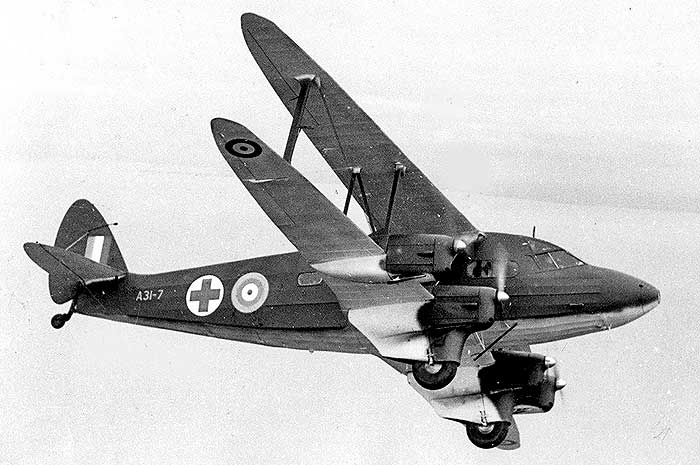
A31-7
in Melbourne in March 1941 prior to delivery to Egypt for
1AAU.
Photo: The Collection
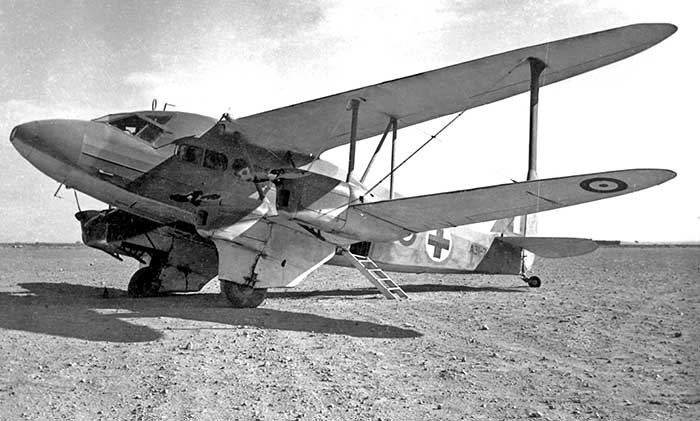
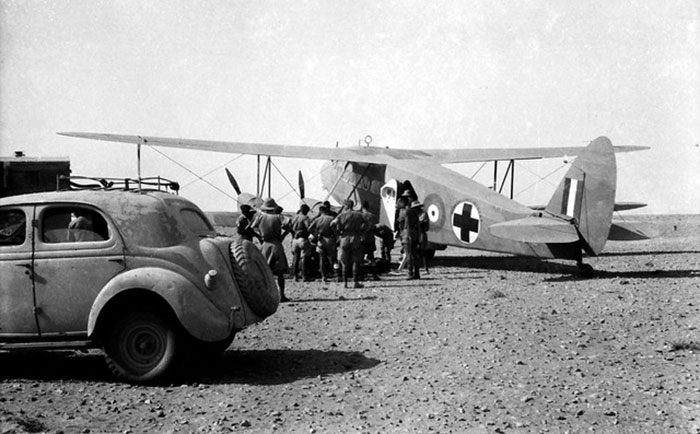

| 6.36 |
Built at Hatfield. Production DH.86A |
| 21.7.36 |
British CofA G-ADYH: British Airways Ltd, Gatwick |
| 9.36 |
Following the crash of British Airways’ DH.86 G-ADYF during a night takeoff from Gatwick 15.9.36, G-ADYH was loaned to RAF at Martlesham for testing. The report was critical of poor rudder and aileron control, and led to the development of the DH.86B with auxiliary fins |
| Modified to DH.86B standard |
|
| 8.40 |
Change of ownership: Railway Air Services Ltd Used on restricted civil passenger services during WWII painted in camouflage, under the control of National Air Communications, Associated Airways Joint Committee |
| 22.10.46 |
Change of ownership: Skytravel Ltd, Speke Airport, Liverpool. Named Denebola |
| 10.47 |
Australian Warren Pennyt purchased G-ADYH at an auction of Skytravel assets held at
Squires Gate Aerodrome, Brighton. Penny had flown his
Lockheed Hudson VH-ASV to England to establish a London office for his
company Intercontinental Air Tours, Sydney. (Warren Penny was experienced on the DH.86 type, which he flew for Union Airways in New Zealand pre-WWII.) |
| 27.10.47 |
Change of ownership: Henry Warren Grindrod Penny, London Trading as Intercontinental Air Tours, London, Athens and Sydney |
| 28.11.47 |
G-ADYH arrived Mascot Aerodrome, Sydney at 6.15pm from London, carrying ten British, Greek and Italian migrants. Captain William T. Mellor of ICAT |
| 2.48 |
G-ADYH
flown from Sydney to RAAF Station Tocumwal NSW by Warren Penny with
radio operator Peter Thurlow. Penny inspected a Lockheed Lodestar
listed for sale by the Commonwealth Disposals Commission. Returned to
Sydney via a stop at Canberra where he had been summoned by the
Minister for Civil Aviation, to be told permission for his overseas
operations had been cancelled. |
| 2.48 |
Warren Penny’s unpublished autobiography states that by
February 1948 ICAT was in a severe financial state. Payments from 30
outstanding migrants from Italy had already been absorbed in running
costs. Penny did a deal with “the owners of an American Douglas C-47 visiting Sydney at the time” to transfer ownership of ICAT Hudson VH-ASV and D.H.86 G-ADYH to them in return for them collecting the 30 migrants from Rome to Sydney |
| Compiler’s note: The DC-3 was actually PI-C233 (identity unknown)
operated by South Eastern, Manila on lucrative migrant charters from
southern Europe to Australia. American Francis Grigware was a principal
of South Eastern DCA investigation report dated 8.3.48 into the migrant charter operators states in a summary of Intercontinental Air Tours: “However it appeared to me some time ago that they had over-invested their money in aircraft and left little ready cash with which to operate. The DH.86B is now being sold to a Mr. M. Khara, a hardware merchant of Rangoon, the intention being to raise some ready cash. Mr. Khara will be using this aircraft between Rangoon, Akyab and Chittagong.” |
|
| 2.48 |
Sold by Penny to Francis James Grigware, Manila, Philippines |
| 1.3.38 |
Hangarage
fees for G-AYDH in the DCA hangar at Darwin from 1.3.38 to 12.4.48 were
among costs listed at Warren Penny's subsequent bankrupcy court hearing. |
| 10.3.48 |
DCA Mascot office cabled DCA Head Office: “G-ADYH cleared ex Sydney to Darwin for overseas flight for disposal. Previously used by Intercontinental Airways.” |
| 10.3.48 |
Damaged on takeoff at Darwin. Starboard
undercarriage brake was seizing during takeoff. The undercarriage collapsed on landing when the aircraft returned. |
| 30.3.48 |
DCA Darwin office memo: “G-ADYH will shortly be leaving for overseas on a ferry flight. Owing to damage to undercarriage, it has no current Certificate of Safety. No certified personnel on station to sign it out.” |
| 2.4.48 |
DCA Head Office responded to Darwin office that G-ADYH must not be allowed to depart Darwin without a valid Certificate of Safety. “This aircraft previously owned by Warren Penny and now purchased it is understood by *Grimshaw.” *actually Francis Grigware |
| 3.5.48 |
DCA Darwin office reply: G-ADYH is reported to be proceeding to Britain on an extended British CofA. A pilot and radio operator arrived Darwin with replacement parts, planning to carry out the repairs. Assembly of new parts delayed pending arrival of suitable engineer from south due no licenced personnel in Darwin |
| 10.5.48 |
Repairs completed at Darwin. New brake shoes were supplied by ANA. Repair signed out by licenced engineer H.F.Jamieson of Intercontinental Air Maintenance Pty Ltd, Sydney |
| 5.48 |
Singapore DCA cabled Ministry of Civil Aviation, London advising that G-ADYH had departed Singapore that month reportedly bound for UK to renew its CofA |
| 6.48 |
British Ministry of Civil Aviation cabled Australian DCA expressing concern that G-ADYH has not reached Britain. “We
cannot help having suspicions that the aircraft may have altered course
to the Middle East.” This no doubt referred to the illegal sale of Australian registered aircraft (Hudsons, Lodestar and DC-5) to the Israeli Air Force |
| G-ADYH in fact was based in Malaya and Burma, operating on
charter to Indonesian independence rebel forces in their military
action against Dutch forces in Netherlands East Indies. Allocated unofficial Republic of Indonesia serial number RI-008, but never painted on the aircraft |
|
| 9.48 |
G-ADYH was unserviceable at Kuala Lumpur, Malaya |
| 7.12.48 |
Malaya Department of Civil Aviation sent
G-ADYH’s expired Certificates of Registration and Airworthiness to the
Ministry of Civil Aviation, London. The paperwork included an
incomplete transfer of ownership form signed by H.W.G.Penny dated
13.4.48. Based on this, MCA cancelled the registration of G-ADYH back-dated to 13.4.48 |
| 19.12.48 |
G-ADYH was among Indonesian rebel aircraft captured during a Dutch military attack on the rebel’s airfield at Maguwo, Java |
| Letter to Editor, Air Pictorial magazine, March 1957 from Hugo Hooftman: “On 19 December 1948 Dutch forces attacked the airfield at Maguwo, near Djokjakarta, which was then in the hands of the Indonesian Republicans. Among the aircraft captured was DH.86B G-ADYH “Denebola”, a former aircraft of Imperial Airways. A few days later I was able to inspect “Denebola” in Bandung and its name was still on the nose; it still carried the British registration. On the fuselage was painted the word “Intercontinental”. On the fin was the name “Skytravel Ltd.” I am afraid that this DH.86 never flew away from Bandung as it was dismantled there.” |
|
| Also captured in the Maguwo airfield raid were other self-styled Republic of Indonesia Air Force aircraft: Dakota RI-001, Avro Anson RI-004 and Catalina RI-006. There were strong Australian links with several of these aircraft and their pilots | |
| Warren Penny’s unpublished biography adds some details: “I had on my staff a copilot named Donati. When the DH.86 went to its new owners, Donati flew it to Singapore and other places for them, until it was captured by the Dutch during the Indonesian war. Years later, whilst in Cyrpus, I got a message to say that one of Skyways’ Yorks carrying troops from England to Fayid in the Canal Zone had hit the ground with its wingtip whilst in the circuit at Fayid during a night landing. The pilot was Captain Donati. He was later after the enquiry demoted to co-pilot and sent to Germany for more experience before being made captain again.” |
|
| 12.48 |
G-ADYH was flown from Maguwo to Bandoeng by Netherlands Air Force pilots |
| c49 |
Broken up at Bandoeng, Indonesia |
| Reported that its four Gipsy Six engines were saved and later used on a locally designed aircraft built at Bandoeng |
| 1.35 |
Built at Hatfield by De Havilland Aircraft Co Ltd. Production DH.86 |
| 28.2.35 |
CofA issued G-ACWD Imperial Airways, Ltd, London. Named Dorado |
| 23.3.36 |
Operated inaugural flight of Imperial Airways Penang-Saigon-Hong Kong return shuttle |
| 22.11.41 |
Impressed by United Kingdom Government from Imperial Airways at Cairo, Egypt |
| 11.41 |
Taken on RAF charge as HK829 |
| RAF 216 Squadron | |
| 4.3.42 |
Delivered to 117 Squadron, Bilbeis. Operated by 117 Sqn B Flight Used to fly supplies and personnel to British Army and RAF forward posts in the Western Desert. |
| 29.5.42 |
Delivered to RAAF No.1 Air Ambulance Unit at Heliopolis, Egypt Three RAF DH.86s had become available for transfer to the Australian unit because 117 Squadron had just re-equipped with Lockheed Lodestars as replacements. |
| 17.3.43 |
Undercarriage collapsed on landing Nefatia North, Egypt. Write-off. |
| 2.36 |
Built at Hatfield by De Havilland Aircraft Co Ltd. Production DH.86A |
| 17.3.36 |
CofA issued G-AEAP Imperial Airways, Ltd, London. Named Demeter |
| .37 |
Reported that all surviving DH.86As were modified to DH.86B standard |
| 22.10.41 |
Impressed by United Kingdom Government from Imperial Airways at Cairo, Egypt |
| 10.41 |
Taken on RAF charge as HK843 |
| 4.3.42 |
Delivered to 117 Squadron, Bilbeis, Egypt. Operated by 117 Sqn B Flight Used to fly supplies and personnel to British Army and RAF forward posts in the Western Desert. |
| 6.42 |
Allocated to Iraq |
| .42 |
Allocated to RAAF No.1 Air Ambulance Unit at Heliopolis, Egypt Three RAF DH.86s had become available for transfer to the Australian unit because 117 Squadron had just re-equipped with Lockheed Lodestars as replacements. |
| 23.7.43 |
Destroyed by fire at Pachino, Sicily, Italy. Flg. Off. Carson was preparing for take off with 4 crew and 12 patients when a Verey pistol cartridge exploded in the cockpit. The aircraft was destroyed by fire but all on board escaped. The propellers had blown burning fabric into a second DH.86 also loaded with casualties being evacuated. It was saved by the action of Cpl. Howlett who had escaped the burning HK843 and run to pull away the burning fabric pieceswith his hands. |
| Photo of HK843 in use with 1AAU shows tailplane without endplates |
| 1.36 |
Built at Hatfield by De Havilland Aircraft Co Ltd. Production DH.86A |
| 20.1.36 |
CofA issued G-ADUE Imperial Airways, Ltd, London. Named Dardanus |
| .37 |
Reported that all surviving DH.86As were modified to DH.86B standard |
| .39 |
Damaged near Wai Chao, China when shot at by Japanese fighter |
| 20.9.41 |
Impressed by United Kingdom Government from BOAC at Cairo, Egypt |
| Taken on RAF charge as AX762. Incorrectly painted as “AX672” over camouflage | |
| RAF 216 Squadron | |
| 4.3.42 |
Delivered to 117 Squadron, Bilbeis. Operated by 117 Sqn B Flight Used to fly supplies and personnel to British Army and RAF forward posts in the Western Desert. |
| 29.5.42 |
Delivered to RAAF No.1 Air Ambulance Unit at Heliopolis, Egypt Three RAF DH.86s had become available for transfer to the Australian unit because 117 Squadron had just re-equipped with Lockheed Lodestars as replacements. |
| 23.6.42 |
Starboard undercarriage collapsed on landing Siwa, Egypt. Still painted as “AX672” |
| 6.42 |
Struck-off RAF charge as damaged Category E |
- Australian Civil Aircraft Register ledgers, Department of Civil Aviation
- National Archives of Australia, Melbourne: DCA files MP113/1: DCA Head Office aircraft files
- National Archives of Australia, Perth: DCA files MP113/1: DCA WA Region aircraft files
- National Archives of Australia, Melbourne: DCA and Customs files relating to G-ADYH
- British Civil Register: G-INFO website
- British Civil Aircraft since 1919, Volume II, A.J.Jackson, Putnam, London, 1972
- De Havilland Aircraft Since 1909, A.J.Jackson, Putnam, London 1978
- Australian Air Force Since 1911, N.M.Parnell & C.A.Lynch, A.H. & A.W.Reed, Sydney, 1976
- Qantas Rising, Sir Hudson Fysh, Angus and Robinson, 1965
- Qantas At War, Sir Hudson Fysh, Angus and Robinson, 1968
- Front Line Airline, E. Bennett-Bremner, Angus and Robinson, 1944
- Flypast-A Record of Aviation in Australia, Neville Parnell & Trevor Boughton, Civil Aviation Authority, 1988
- Wings of Gold, How the aeroplane developed New Guinea, James Sinclair, Pacific Publications, 1978
- Cockpit & Spanner, Frank Colquhoun, Maylands Historical Society, Perth, 2001
- The Migrant Caper, Geoff Goodall - on this website
- Captain R.O.Mant interview, Greg Banfield, Avation Heritage, Aviation Historical Society of Australia
- South East Asia Civil Aircraft Registers: India, Air-Britain 1979
- Air Crash Volume 1, Macarthur Job, Aerospace Publications, Canberra 1991
- Air Crash Volume 2, Macarthur Job, Aerospace Publications, Canberra 1992
- Edgar C. Johnston papers, held by Civil Aviation Historical Society,
Melbourne: correspondence over DH.86 airworthiness concerns,
impressment of civil aircraft 1940-1941- Air Crash Volume 2, Macarthur Job, Aerospace Publications, Canberra 1992
- Aircraft in Australia series: DH.86, compiled by John Hopton, uncompleted draft 8.10.99
- Aviation Historical Society of Australia-Journal, Vol.19 No.2, Greg Banfield interview with Captain R.O.Mant
- Aviation Historical Society of Australia-Journal, Vol 21 No.4, Greg Banfield interview with Captain Ken Jackson
- Historic Civil Register of Australia - G-UAA to VH-UZZ, Bert Cookson, Austairdata Publications
- Airlines & Aircraft of the Ansett Group 1921-2002, CD Edition 8, December 2011, Fred Niven
- Harrison Air Log, John T. Harrison, commercial photographer
- The Singapore Express - QEA and the DH86 Saga, David Crotty, The Aviation Historian
Back to the Australian Aviation Menu